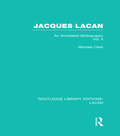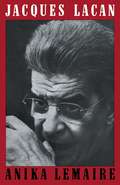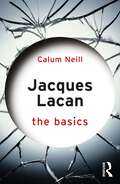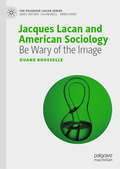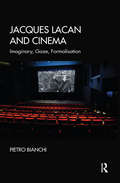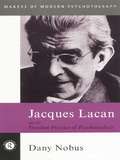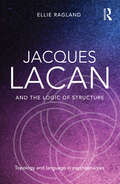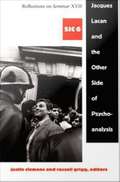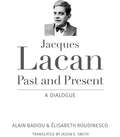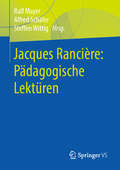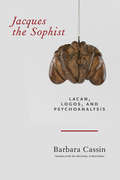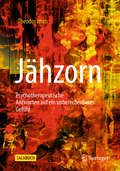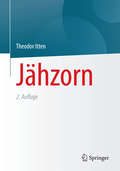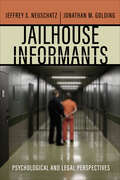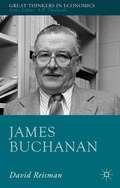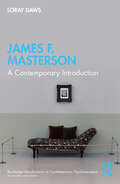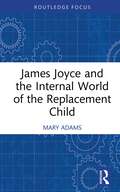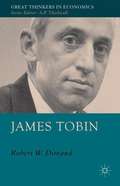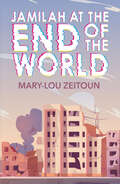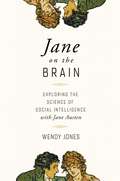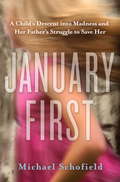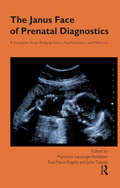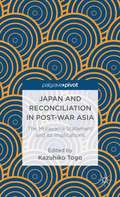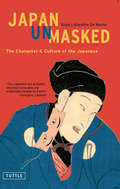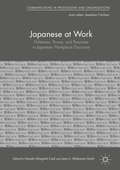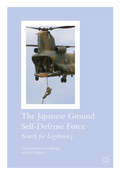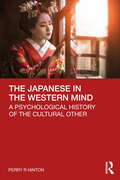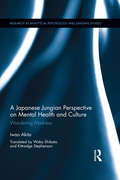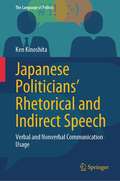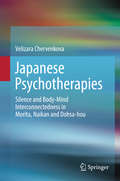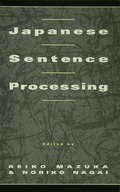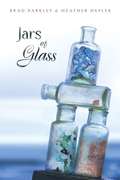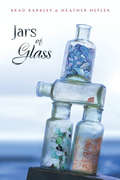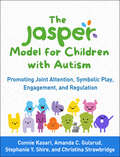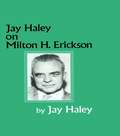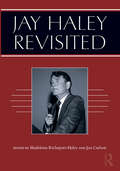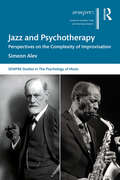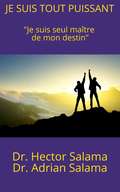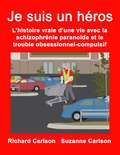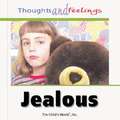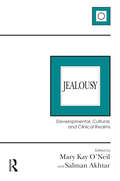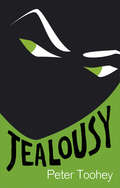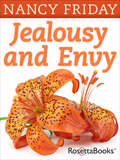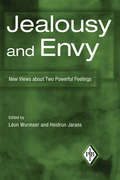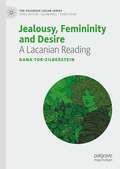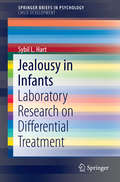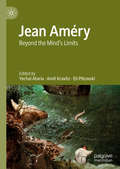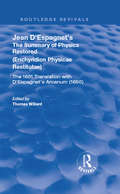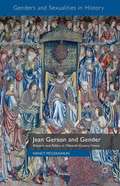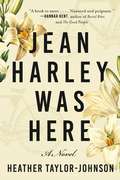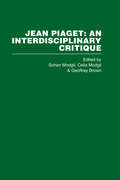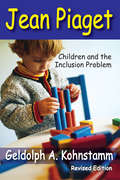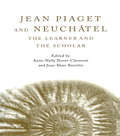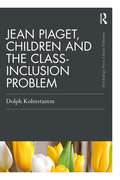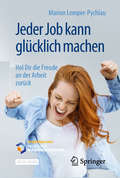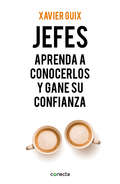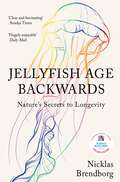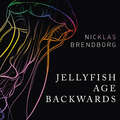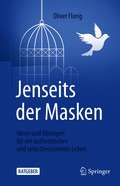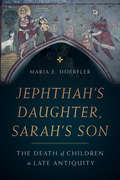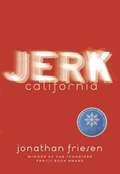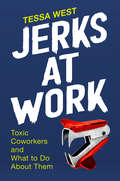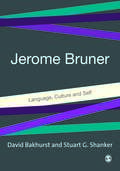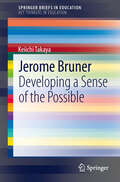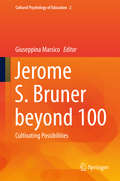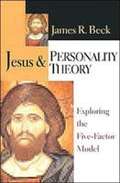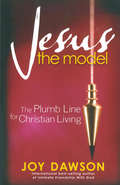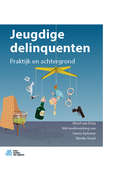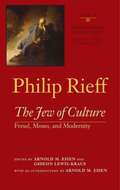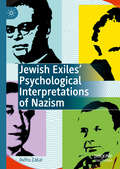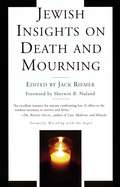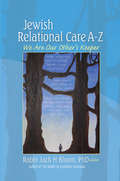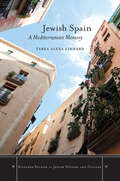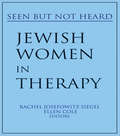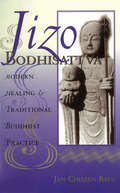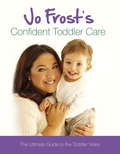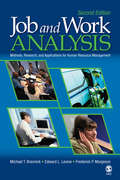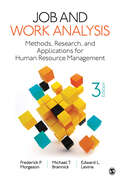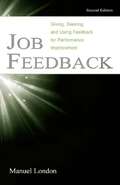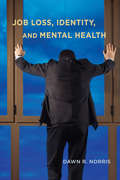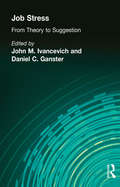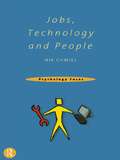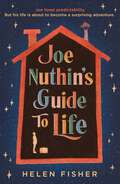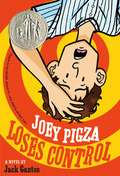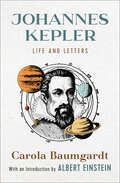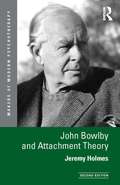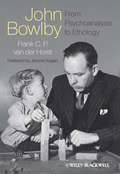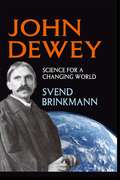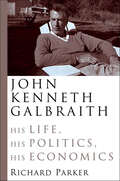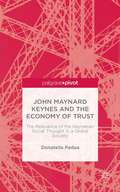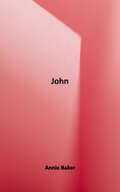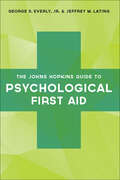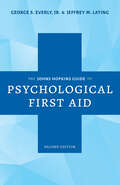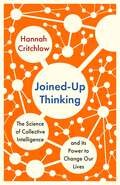- Table View
- List View
Jacques Lacan: An Annotated Bibliography (Routledge Library Editions: Lacan)
by Michael P. ClarkThis bibliography in two volumes, originally published in 1988, lists and describes works by and about Jacques Lacan published in French, English, and seven other languages including Japanese and Russian. It incorporates and corrects where necessary all information from earlier published bibliographies of Lacan’s work. Also included as background works are books and essays that discuss Lacan in the course of a more general study, as well as all relevant items in various bibliographic sources from many fields.
Jacques Lacan
by Anika LemaireThe work of Jaques Lacan, eminent French psychoanalyst and influential thinker (1901-1981), is recognized as being of vital importance to psychoanalysts, philosophers, and all those concerned with the the study of man and language. Its value is not limited to the field of psychoanalysis alone, but provides the basis for a new philosophy of man and a new theory of discourse. It is, however, notoriously difficult for the non-specialist reader to come to terms with Lacan's reading of Freud and his investigations of the unconscious. Until now, there has been no satisfactory general introduction to Lacan, and this first general exposition of his work, translated and revised from the French edition, is designed to provide the conceptual tools which will enable the reader to study Lacan using the original texts.
Jacques Lacan: The Basics (The Basics)
by Calum NeillJacques Lacan: The Basics provides a clear and succinct introduction to the work of Jacques Lacan, one of the key thinkers of the twentieth century. Lacan’s ideas are applied in the study of the humanities, politics, and psychology as well as contemporary media and the arts, but their complexity makes them impenetrable to many. This book is unique in explaining the key concepts and context, from Lacan’s understanding of psychoanalysis to drive and desire, in an accessible way without diluting them beyond meaning. Examples from popular culture are used throughout to emphasise the ideas being discussed and a full glossary and list of resources for further reading encourages additional exploration. This engaging and accessible text is essential reading for all those interested in Lacan and his work, as well as students of psychology, psychoanalysis, literature, politics, cultural studies, film studies, and more.
Jacques Lacan and American Sociology: Be Wary of the Image (The Palgrave Lacan Series)
by Duane RousselleIn this Palgrave Pivot, Duane Rousselle aims to disrupt the hold that pragmatist ideology has had over American sociology by demonstrating that the social bond has always been founded upon a fundamental and primordial bankruptcy. Using the Lacanian theory of “capitalist discourse,” Rousselle demonstrates that most of early American sociology suffered from an inadequate account of the “symbolic” within the mental and social lives of the individual subject. The psychoanalytic aspect of the social bond remained theoretically undeveloped in the American context. Instead it is the “image,” a product of the imaginary, which takes charge over any symbolic function. This intervention into pragmatic sociology seeks to recover the tradition of “grand theory” by bringing psychoanalytical and sociological discourse into fruitful communication with one another.
Jacques Lacan and Cinema: Imaginary, Gaze, Formalisation
by Pietro BianchiPsychoanalysis has always been based on the eclipse of the visual and on the primacy of speech. The work of Jacques Lacan though, is strangely full of references to the visual field, from the intervention on the mirror stage in the Forties to the elaboration of the object-gaze in the Sixties. As a consequence, a long tradition of film studies used Lacanian psychoanalysis in order to explain the influence of the subject of the unconscious on the cinematographic experience. What is less known is how the late Lacanian reflection on the topic of analytic formalization opened up a further dimension of the visual that goes beyond the subjective experience of vision: not in the direction of a mystical ineffable but rather toward a subtractive mathematisation of space, as in non-Euclidean geometries. In an exhaustive overview of the whole Lacanian theorization of the visual, counterpointed by a confrontation with several thinkers of cinema (Eisenstein, Straub-Huillet, Deleuze, Ranciere), the book will lead the reader toward the discovery of the most counterintuitive approaches of Lacanian psychoanalysis to the topic of vision.
Jacques Lacan and the Freudian Practice of Psychoanalysis (Makers of Modern Psychotherapy)
by Dany NobusJacques Lacan and the Freudian Practice of Psychoanalysis paints a completely new picture of the man and his ideas. The book suceeds in showing how ideas can become more accessible, and re-evaluates his significance within the field of psychodynamic psychotherapy.The book is structured thematically around five key issues: diagnosis, the analyst's position during the treatment, the management of transference, the formulation of interpretations, and the organisation of analytic training. For each of these issues, Lacan's entire work both published and unpublished material, has been taken into account and theoretical principles have been illustrated with clinical examples. The book also contains the first complete bibliography of Lacan's works in English.Clear, detailed, and wide ranging, Jacques Lacan and the Freudian Practice of Psychoanalysis will prove essential reading, not only for professionals and students within the fields of psychology and psychiatry, but for all those keen to discover a new Lacan.
Jacques Lacan and the Logic of Structure: Topology and language in psychoanalysis
by Ellie RaglandLacan postulated that the psyche can be understood by means of certain structures, which control our lives and our desires, and which operate differently at different logical moments or stages of formation. Jacques Lacan and the Logic of Structure offers us a reading of the major concepts of Lacan in terms of his later topological theory and aims to show how this was always a concern for Lacan and not only an issue in the last seminars. Ellie Ragland discusses how various stages of formation can be uncovered topologically within language itself, and operate to place certain properties – fantasy, the drive, jouissance, discourse and ethics in language itself. In this way she explores not only how language actually works in tandem with the properties, but also gives a different idea of what knowledge actually is and what implications that may have for reimagining and reworking differential/diagnostic structures. Jacques Lacan and the Logic of Structure is a compelling exponent of the innovative approaches Lacan takes to rethinking what psychoanalysis is and what it can do to enlighten psychoanalysts and treat patients. It will be essential reading to psychoanalysts, psychoanalytic psychotherapists training graduate students in the fields of film, literary, gender and cultural studies.
Jacques Lacan and the Other Side of Psychoanalysis: Reflections on Seminar XVII sic 6
by Justin Clemens Russell GriggThis collection is the first extended interrogation in any language of Jacques Lacan's Seminar XVII. Originally delivered just after the Paris uprisings of May 1968, Seminar XVII marked a turning point in Lacan's thought; it was both a step forward in the psychoanalytic debates and an important contribution to social and political issues. Collecting important analyses by many of the major Lacanian theorists and practitioners, this anthology is at once an introduction, critique, and extension of Lacan's influential ideas. The contributors examine Lacan's theory of the four discourses, his critique of the Oedipus complex and the superego, the role of primal affects in political life, and his prophetic grasp of twenty-first-century developments. They take up these issues in detail, illuminating the Lacanian concepts with in-depth discussions of shame and guilt, literature and intimacy, femininity, perversion, authority and revolt, and the discourse of marketing and political rhetoric. Topics of more specific psychoanalytic interest include the role of objet a, philosophy and psychoanalysis, the status of knowledge, and the relation between psychoanalytic practices and the modern university. Contributors. Geoff Boucher, Marie-Hlne Brousse, Justin Clemens, Mladen Dolar, Oliver Feltham, Russell Grigg, Pierre-Gilles Guguen, Dominique Hecq, Dominiek Hoens, ric Laurent, Juliet Flower MacCannell, Jacques-Alain Miller, Ellie Ragland, Matthew Sharpe, Paul Verhaeghe, Slavoj Žižek, Alenka Zupancic
Jacques Lacan, Past and Present: A Dialogue
by Alain Badiou Elisabeth RoudinescoIn this dialogue, Alain Badiou shares the clearest, most detailed account to date of his profound indebtedness to Lacanian psychoanalysis. He explains in depth the tools Lacan gave him to navigate the extremes of his other two philosophical "masters," Jean-Paul Sartre and Louis Althusser. Élisabeth Roudinesco supplements Badiou's experience with her own perspective on the troubled landscape of the French analytic world since Lacan's death—critiquing, for example, the link (or lack thereof) between politics and psychoanalysis in Lacan's work. Their exchange reinvigorates how the the work of a pivotal twentieth-century thinker is perceived.
Jacques Rancière: Pädagogische Lektüren
by Ralf Mayer Alfred Schäfer Steffen WittigEs sind die zugleich politischen und ästhetischen Einsatzpunkte Jacques Rancières, die das pädagogische Nachdenken herausfordern: Angesprochen sind damit etwa die Intervention in ein- wie ausschließende ‚Ordnungen des Sinnlichen‘, die Artikulation eines ‚Unvernehmens‘ über die Unterstellung von je spezifischen Gleichheitsmotiven und das Plädoyer für ein ästhetisches Regime, das in unterschiedlichen Feldern definitive und privilegierte Sichtweisen irritiert. Diese Herausforderungen gelten nicht nur für Begründungen und Qualifizierungen von Praktiken und Institutionen; ebenso erscheinen pädagogische Problemstellungen stets disziplinübergreifend in Spannungsfeldern von Politik und (polizeilicher) Ordnung situiert.
Jacques the Sophist: Lacan, Logos, and Psychoanalysis
by Barbara CassinSophistry, since Plato and Aristotle, has been philosophy’s negative alter ego, its bad other. Yet sophistry’s emphasis on words and performativity over the fetishization of truth makes it an essential part of our world’s cultural, political, and philosophical repertoire. In this dazzling book, Barbara Cassin, who has done more than anyone to reclaim a mode of thought that traditional philosophy disavows, shows how the sophistical tradition has survived in the work of psychoanalysis.In a highly original rereading of the writings and seminars of Jacques Lacan, together with works of Freud and others, Cassin shows how psychoanalysis, like the sophists, challenges the very foundations of scientific rationality. In taking seriously equivocations, jokes, and unfinishable projects of interpretation, the analyst, like the sophist, allows performance, signifier, and inconsistency to reshape truth.This witty, brilliant tour de force celebrates how psychoanalysts have become our culture’s key dissidents and register, in Lacan’s words, “the presence of the sophist in our time.”
Jähzorn: Psychotherapeutische Antworten auf ein unberechenbares Gefühl
by Theodor IttenDie zerstörerische Wucht des Jähzorns ist bekannt, sozialwissenschaftlich wurde sie bisher tabuisiert. Beruflich und privat sind wir Zeugen von Ausbrüchen des Jähzorns. Zur Untermauerung dieser Beobachtungen wurden an die 600 Personen zu ihren persönlichen Erfahrungen mit Jähzorn befragt. Das Ergebnis: 24 % der Befragten sind jähzornig. Das im Jahr 2007 erstmalig, im deutschsprachigen Raum, veröffentlichte Buch zum plötzlichen, anfallsmässigen Zorn, bietet einen vielschichtigen, interessanten Gang durch die Kulturgeschichte und Sozialpsychologie des Jähzorns. Es gibt Antworten auf folgende Fragen: „Wo kommt der Jähzorn her? Wie zeigt sich Jähzorn? Was können wir tun?“ Verschiedene Perspektiven und Erfahrungen von Täter und Opfer werden geschildert und im sozialkulturellen Kontext erläutert. Bewegende Einzelfallstudien liefern zahlreiche hilfreiche Hinweise und Einsichten zum Verständnis des Jähzorns. Die psychotherapeutischen Antworten auf dieses unberechenbare Gefühl sind in der dritten, überarbeiteten Auflage, vielfältigere und facettenreichere Quellen. Möglichkeiten von therapeutischen Aspekten der Selbstbefähigung werden aufgezeigt, mit gepflegter, dauerhafter Übung sind sie auch umsetzbar. Ein Buch für Betroffene, Angehörige und Wirkende in helfenden, therapeutischen Berufen.
Jähzorn: Psychotherapeutische Antworten auf ein unberechenbares Gefühl
by Theodor IttenDie zerstörerische Wucht des Jähzorns ist bekannt, sozialwissenschaftlich wurde sie bisher tabuisiert. Beruflich und privat sind wir Zeugen von Ausbrüchen des Jähzorns. Zur Untermauerung dieser Beobachtungen wurden an die 600 Personen zu ihren persönlichen Erfahrungen mit Jähzorn befragt. Das Ergebnis: 24 % der Befragten sind jähzornig. Das im Jahr 2007 erstmalig, im deutschsprachigen Raum, veröffentlichte Buch zum plötzlichen, anfallsmässigen Zorn, bietet einen vielschichtigen, interessanten Gang durch die Kulturgeschichte und Sozialpsychologie des Jähzorns. Es gibt Antworten auf folgende Fragen: „Wo kommt der Jähzorn her? Wie zeigt sich Jähzorn? Was können wir tun?“ Verschiedene Perspektiven und Erfahrungen von Täter und Opfer werden geschildert und im sozialkulturellen Kontext erläutert. Bewegende Einzelfallstudien liefern zahlreiche hilfreiche Hinweise und Einsichten zum Verständnis des Jähzorns. Die psychotherapeutischen Antworten auf dieses unberechenbare Gefühl sind in der zweiten, überarbeiteten Auflage, vielfältigere und facettenreichere Quellen. Möglichkeiten zum Selbstmanagement werden aufgezeigt, mit gepflegter, dauerhafter Übung sind sie auch umsetzbar. Ein Buch für Betroffene, Angehörige und Wirkende in helfenden, therapeutischen Berufen.
Jailhouse Informants: Psychological and Legal Perspectives (Psychology and Crime)
by Jeffrey S Neuschatz Jonathan M GoldingOffers a new understanding of jailhouse informants and the role they play in wrongful convictions Jailhouse informants—witnesses who testify in a criminal trial, often in exchange for some incentive—are particularly persuasive to jurors. A jailhouse informant usually claims to have heard the defendant confess to a crime while they were incarcerated together. Research shows that such testimony increases the likelihood of a guilty verdict. But it is also a leading contributor to wrongful convictions. Informants, after all, are generally criminals who are offering testimony in return for some key motivator, such as a reduced sentence. This book offers a broad overview of the history and legal and psychological issues surrounding the testimony of jailhouse informants. It provides groundbreaking psychological research to address how they are used, the number of convictions that have ultimately been overturned on other evidence, how such informants are perceived in the courtroom, and by what means jurors might be informed about the risks of this type of testimony. The volume provides a much-needed examination of legal remedies to the impact of jailhouse informants and suggests best practices in dealing with jailhouse informant testimony in court. There is a critical need to understand the influence of jailhouse informants and how their testimony can best be handled in court in the interests of justice. Jailhouse Informants is the first work of its kind that rises to the challenge of answering these difficult questions.
James Buchanan
by David ReismanJames Buchanan (1919-2013) was awarded the Nobel Prize in Economics in 1986 for his synthesis of market economics and political democracy. A libertarian, a contractarian, a constitutionalist, Buchanan saw the social world as a network of individuals revealing preferences and negotiating exchanges. Self-interest that might otherwise have led to the war of each against all is channelled into the division of labour and capitalism by consent. Trade gives rational individuals the opportunity to increase each other's felt well-being. Gain-seeking anarchy is the economist's utopia but still a protective State is needed to ensure that agreements are honoured and the rules obeyed. Buchanan made himself a missionary for binding agreements and good rules. Without them, he warned, we would surely fight. Using morals when other economists used mathematics, Buchanan argued a market economist's case for tolerance of diversity, unanimity of consensus and uncompromising respect. This book, James Buchanan, seeks to explain and evaluate the thought-provoking insights of a prolific and original thinker who enriched the ethical aspirations of a frequently dismal science.
James F. Masterson: A Contemporary Introduction (Routledge Introductions to Contemporary Psychoanalysis)
by Loray DawsIn this volume, Loray Daws traces the life and work of Dr. James F. Masterson, with a focus on the scientific development and later expansion of the six developmental stages of the Masterson Method. Exploring more than 15 of Masterson’s volumes, as well as countless articles, Daws shows how Masterson’s approach to Object Relations and the developmental self can serve clinicians in both conceptualizing and treating borderline, narcissistic, and schizoid disorders of self. Considering the pioneering and innovative nature of Masterson’s work, Daws looks at how he creatively expanded on Freud’s theories on repression, successfully developing therapeutically sound ways to touch and transform developmental trauma and trauma reflected in a deep abandonment depression. James F. Masterson: A Contemporary Introduction will be of interest to students in psychology, psychiatry, and psychiatric nursing, as well as psychoanalytically orientated psychotherapists, psychoanalysts, and those specializing in the ever-growing field of the treatment of the disorders of the self.
James Joyce and the Internal World of the Replacement Child (Routledge Focus on Mental Health)
by Mary AdamsThis book is an exploration of the internal world of James Joyce with particular emphasis on his being born into his parents’ grief at the loss of their firstborn son, offering a new perspective on his emotional difficulties. Mary Adams links Joyce’s profound sense of guilt and abandonment with the trauma of being a ‘replacement child’ and compares his experience with that of two psychoanalytic cases, as well as with Freud and other well-known figures who were replacement children. Issues such as survivor guilt, sibling rivalry, the ‘illegitimate’ replacement son, and the ‘dead mother’ syndrome are discussed. Joyce is seen as maturing from a paranoid, fearful state through his writing, his intelligence, his humour and his sublime poetic sensibility. By escaping the oppressive aspects of life in Dublin, in exile he could find greater emotional freedom and a new sense of belonging. A quality of claustrophobic intrusive identification in Ulysses contrasts strikingly with a new levity, imaginative identification, intimacy and compassion in Finnegans Wake. James Joyce and the Internal World of the Replacement Child highlights the concept of the replacement child and the impact this can have on a whole family. The book will be of interest to psychoanalysts, psychoanalytic psychotherapists and child psychotherapists as well as students of English literature, psychoanalytic studies and readers interested in James Joyce.
James Tobin
by Robert W. DimandJames Tobin, 1981 Nobel laureate in economics, was the outstanding monetary economist among American Keynesian economists. This book, the first written about James Tobin, examines his leading role as a Keynesian macroeconomist and monetary economist, and considers the continuing relevance of his ideas.
Jamilah at the End of the World
by Mary-Lou ZeitounSeventeen-year-old Jamilah Monsour makes plans for what she's certain is the beginning of the climate change catastrophe that will end the world. Luckily, Jamilah knows what has to be done to save her family: reluctantly her parents allow her to transform the back alley garage into a bunker, but they draw the line when she announces she’s going to skip university and instead use the money they had saved for her education to buy solar panels and a generator. When an electricity blackout strikes, Jamilah's climate change anxiety kicks into high gear and she ends up staying out all night, infuriating her father who is done with all this doomsday nonsense. Distributed in the U.S by Lerner Publishing Group.
Jane on the Brain: Exploring The Science Of Social Intelligence With Jane Austen
by Wendy JonesAn Austen scholar and therapist reveals Jane Austen's intuitive ability to imbue her characters with hallmarks of social intelligence—and how these beloved works of literature can further illuminate the mind-brain connection. Why is Jane Austen so phenomenally popular? Why do we read Pride and Prejudice again and again? Why do we delight in Emma’s mischievous schemes? Why do we care that Anne Elliot of Persuasion suffers? We care because it is our biological destiny to be interested in people and their stories—the human brain is a social brain. And Austen’s characters are so believable, that for many of us, they are not just imaginary beings, but friends whom we know and love. And thanks to Austen's ability to capture the breadth and depth of human psychology so thoroughly, we feel that she empathizes with us, her readers. Humans have a profound need for empathy, to know that we are not alone with our joys and sorrows. And then there is attachment, denial, narcissism, and of course, love, to name a few. We see ourselves and others reflected in Austen’s work. Social intelligence is one of the most highly developed human traits when compared with other animals How did is evolve? Why is it so valuable? Wendy Jones explores the many facets of social intelligence and juxtaposes them with the Austen cannon. Brilliantly original and insightful, this fusion of psychology, neuroscience, and literature provides a heightened understanding of one of our most beloved cultural institutions—and our own minds.
January First: A Child's Descent into Madness and Her Father's Struggle to Save Her
by Michael SchofieldMichael Schofield's daughter January is at the mercy of her imaginary friends, except they aren't the imaginary friends that most young children have; they are hallucinations. And January is caught in the conflict between our world and their world, a place she calls Calalini. Some of these hallucinations, like "24 Hours," are friendly and some, like "400 the Cat" and "Wednesday the Rat," bite and scratch her until she does what they want. They often tell her to scream at strangers, jump out of buildings, and attack her baby brother. At six years old, January Schofield, "Janni," to her family, was diagnosed with schizophrenia, one of the worst mental illnesses known to man. What's more, schizophrenia is 20 to 30 times more severe in children than in adults and in January's case, doctors say, she is hallucinating 95 percent of the time that she is awake. Potent psychiatric drugs that would level most adults barely faze her. January First captures Michael and his family's remarkable story in a narrative that forges new territory within books about mental illness. In the beginning, readers see Janni's incredible early potential: her brilliance, and savant-like ability to learn extremely abstract concepts. Next, they witnesses early warning signs that something is not right, Michael's attempts to rationalize what's happening, and his descent alongside his daughter into the abyss of schizophrenia. Their battle has included a two-year search for answers, countless medications and hospitalizations, allegations of abuse, despair that almost broke their family apart and, finally, victories against the illness and a new faith that they can create a life for Janni filled with moments of happiness. A compelling, unsparing and passionate account, January First vividly details Schofield's commitment to bring his daughter back from the edge of insanity. It is a father's soul-baring memoir of the daily struggles and challenges he and his wife face as they do everything they can to help Janni while trying to keep their family together. From the Hardcover edition.
The Janus Face of Prenatal Diagnostics: A European Study Bridging Ethics, Psychoanalysis, and Medicine
by Eve-Marie Engels Marianne Leuzinger-Bohleber John TsiantisCoping with modern technology in the life sciences (biology and medicine) became a major issue for people living in the Twentieth Century, and continues to be so in the present century. Biotechnology creates new opportunities and possibilities, but also new dangers, risks, and ethical concerns. In this volume, ethical dilemmas in the context of a specific biomedical technology are discussed. Experts in ethics, philosophy, psychoanalysis, and medicine jointly investigated a field of prenatal and genetic research that seems particularly challenging: prenatal diagnostics. In many European countries amniocentesis, for example, is a routine diagnostic tool for women becoming pregnant after the age of thirty-five. In recent decades, enormous progress has been made in diagnosing genetically-based diseases and other serious prenatal abnormalities. Today, we know that a positive prenatal genetic diagnostic creates distress for all women and their partners, and necessitates making the difficult decision as to whether or not to allow the pregnancy to continue. As is demonstrated in this volume through the summaries of interviews with couples, the reactions of women and their partners who are facing this situation can be very different. The new and innovative interdisciplinary dialogue on this topic that is presented in this volume offers a deeper understanding of the ethical dilemmas raised by prenatal and genetic diagnostics, and explores ways to support couples in this extremely difficult situation.
Japan and Reconciliation in Post-war Asia
by Kazuhiko TogoTaking a comparative approach and bringing together perspectives from Japan, China, Korea, and Taiwan, this volume considers former Japanese prime minister Tomiichi Murayama's 1995 apology statement, the height of Japan's post-war apology, and examines its implications for memory, international relations, and reconciliation in Asia.
Japan Unmasked: The Character & Culture of the Japanese (Tuttle Classics)
by Boye Lafayette De MenteThe growing globalization of world business, culture and communication--and Japan's increasingly important role as a leader in that world--makes understanding Japanese culture critical for business people, diplomats, students, educators and anyone else with an interest in Japan.<P><P>Westerners have recognized--and analyzed--the many unique aspects of Japanese culture since they first set foot in Japan in the 16th century. The special talents (and weaknesses) that characterize the Japanese way of life are by now well-documented. But few Westerners really understand the beliefs and values that underlie how the Japanese think and act, how and why these attributes have been preserved in Japanese culture from ancient times through the modern day, or the critical role they play in today's Japanese society.In Japan Unmasked veteran Japanologist and author Boye Lafayette De Mente explores the social, cultural, and psychological characteristics responsible for the unique nature of modern-day Japanese culture-- the real "face" behind the "mask"--and demonstrates how they have brought the Japanese to their central role on the world stage.
Japanese at Work: Politeness, Power, And Personae In Japanese Workplace Discourse (Communicating In Professions And Organizations Ser.)
by Haruko Minegishi Cook Janet S. Shibamoto-SmithThis book empirically explores how different linguistic resources are utilized to achieve appropriate workplace role inhabitance and to achieve work-oriented communicative ends in a variety of workplaces in Japan. Appropriate role inhabitance is seen to include considerations of gender and interpersonal familiarity, along with speaker orientation to normative structures for marking power and politeness. This uniquely researched edited collection will appeal to scholars of workplace discourse and Japanese sociolinguistics, as well as Japanese language instructors and adult learners of Japanese. It is sure to make a major contribution to the cross-linguistic/cultural study of workplace discourse in the globalized context of the twenty-first century.
The Japanese Ground Self-Defense Force
by Robert D. Eldridge Paul MidfordBased on extensive Japanese-language materials, this book is the first to examine the development of Japan's Ground Self-Defense Force. It addresses: how the GSDF was able to emerge as the post-war successor of the Imperial Japanese Army despite Japan's anti-militarist constitution; how the GSDF, despite the public skepticism and even hostility that greeted its creation, built domestic and international legitimacy; and how the GSDF has responded to changes in international and domestic environments. This path-breaking study of the world's third-largest-economic power's ground army is timely for two reasons. First, the resurgence of tensions in Northeast Asia over territorial disputes, and the emphasis recent Japanese governments have placed on using the GSDF for defending Japan's outlying islands is driving media coverage and specialist interest in the GSDF. Second, the March 11, 2011 Great East Japan Earthquake and Tsunami has focused global attention on the GSDF as Japan's lead disaster relief organization. This highly informative and thoroughly researched book provides insight for policy makers and academics interested in Japanese foreign and defense policies.
The Japanese in the Western Mind: A Psychological History of the Cultural Other
by Perry R HintonThis fascinating book is an insightful exploration of Western perceptions and representations of Japanese culture and society, drawing on social and cultural psychological ideas around stereotypes and intercultural relations. Hinton considers how the West views the Japanese as an ideologically different “other”, and proposes a cultural theory of stereotypes from which to explore Western observations of the Japanese. The book explores Western socio-cultural representations of the Japanese alongside Edward Said’s well-known theory of Orientalism. It examines the West’s intercultural relationship with Japan, and how this has changed over time, to show how the Japanese have been represented in the Western mind throughout history, to the present day. Hinton argues that our view of other cultures is based on our own cultural expectations, which involve complex issues of meaning-making and perceived cultural differences. This book foregrounds the research through accounts of Westerners about the Japanese, to reveal how cultural representations can influence the ways in which people from different cultures communicate in interaction, and how intercultural understanding or misunderstanding can arise. By reflecting on the changing Western representations of the Japanese, and how and why these have emerged, this book will be of interest to students, academics and general readers interested in stereotypes, cultural psychology, intercultural communication, anthropology and Japanese culture and history.
A Japanese Jungian Perspective on Mental Health and Culture: Wandering madness (Research in Analytical Psychology and Jungian Studies)
by Iwao AkitaA Japanese Jungian Perspective on Mental Health and Culture: Wandering Madness explores differences between Western and Japanese models of mental health. It argues that while the advent of modern mental health has brought about seminal changes in our understanding of and relationship to those who face its challenges, the cure also seems to be something of the cause, as the classification of mental disorders continues to expand and increasing numbers of people show up to fill them. In this book, psychiatrist and Jungian analyst Iwao Akita presents a new theory of psycheology in order to highlight what has been lost in our rush to medicalize the psyche, as well as offer a remedy for restoring balance. Drawing upon examples from both Japanese and Western cultures, Dr. Akita discusses an alternative perspective to the polarized viewpoint towards which the West tends. He distinguishes the concept of madness from psychopathology and outlines its dynamics through numerous clinical and cultural examples. He describes the underlying dynamics of substance use and personality disorders, makes important links between these conditions, and clarifies how they can develop into madness. With references to familiar stories and myths from Western and Japanese cultures, this book makes an important contribution to our understanding of mental illness and health, while also making us more aware of how these issues are common to the human experience. This book will be of key interest to academics, researchers, and postgraduate students in the fields of psychoanalysis, Jungian and Post-Jungian studies, and mental health studies. It will also appeal to psychiatrists and other mental health professionals, as well as those with a particular interest in substance use, personality disorders, madness, and cross-cultural comparisons of mental health models.
Japanese Politicians’ Rhetorical and Indirect Speech: Verbal and Nonverbal Communication Usage (The Language of Politics)
by Ken KinoshitaThis book presents a new approach to the analysis of political psychology, political culture, and communication. Using data from Japanese political interviews and parliamentary deliberations, it reveals how Japanese politicians address their audience. In addition to analyzing the use of verbal political rhetoric, the book shows that nonverbal communication is highly relevant as well. In a context where political leaders are becoming increasingly important, identifying the techniques used by Japanese politicians – especially facial expressions, hand gestures, and other forms of body language – to gain support from the audience, leads us to consider communication practices of political leaders around the world. Politicians adopt different communication styles based on their specific electoral system. The more single-seat constituency political candidates use rhetoric, the greater their chance of appealing to voters. In addition, the use of personal experiences and others' speech quotations function as effective political rhetoric, further attracting the audience’s attention. In short, this book presents a more comprehensive and holistic picture of political “rhetoric” than usually offered by other studies of political communication.
Japanese Psychotherapies: Silence And Body-mind Interconnectedness In Morita, Naikan And Dohsa-hou
by Velizara ChervenkovaThis book discusses both the theoretical and practical aspects of three Japanese psychotherapeutic approaches - Morita, Naikan, and Dohsa-hou. Specifically, it tracks how the strong cultural specificities of these approaches gather into two focal points, giving rise to the therapeutic power of silence on one hand, and to body-mind interconnectedness on the other. It first describes the development of the three psychotherapies in chronological order, and then goes on to highlight the research that explains their dynamics and at the same time elaborates on their potential for universal applicability hidden behind otherwise unquestionable cultural nuances. This well-structured work fills the gap in the English-language literature on Japanese psychotherapies.
Japanese Sentence Processing
by Reiko Mazuka Noriko NagaiThis volume is a direct result of the International Symposium on Japanese Sentence Processing held at Duke University. The symposium provided the first opportunity for researchers in three disciplinary areas from both Japan and the United States to participate in a conference where they could discuss issues concerning Japanese syntactic processing. The goals of the symposium were three-fold: * to illuminate the mechanisms of Japanese sentence processing from the viewpoints of linguistics, psycholinguistics and computer science; * to synthesize findings about the mechanisms of Japanese sentence processing by researchers in these three fields in Japan and the United States; * to lay foundations for future interdisciplinary research in Japanese sentence processing, as well as international collaborations between researchers in Japan and the United States. The chapters in this volume have been written from the points of view of three different disciplines, with various immediate objectives -- from building usable speech understanding systems to investigating the nature of competence grammars for natural languages. All of the papers share the long term goal of understanding the nature of human language processing mechanisms. The book is concerned with two central issues -- the universality of language processing mechanisms, and the nature of the relation between the components of linguistic knowledge and language processing. This volume demonstrates that interdisciplinary research can be fruitful, and provides groundwork for further research in Japanese sentence processing.
Jars of Glass: A Novel
by Brad Barkley Heather HeplerTeenage sisters Chloe and Shana recall fondly the days when their mother wove stories about kingdoms under the sea. Now that Mom is "away", Chloe does not allow herself to believe in fairy tales. She is too busy caring for her adopted brother, Micah, because Dad has become withdrawn. Shana copes by escaping every night under the cover of Goth garb. The day the family visits Mom for the first time is the day Chloe learns why Shana will never allow their mother to return. It is up to the sisters to pull together and form a new definition of family.
Jars of Glass
by Heather Hepler Brad BarkleyFrom the critically acclaimed authors of Scrambled Eggs at Midnight and Dream Factory comes a poignant story of two sisters. Chloe and Shana want the same thing?for everything to go back to normal, the way it was before their mom went to the hospital. But both sisters know that things can never be the same. While Chloe wants their mom to come home so they can be a family again, Shana never wants to see their mother. And while Shana is trying to escape her problems by hiding under a new persona, Chloe is left trying to be the responsible one. Then things go from bad to worse, and the sisters are forced to band together and redefine what it means to be a family.
Jarvis Clutch - Social Spy
by Melvin D. LevineSocial interactions are often the most stressful aspect of adolescent life. In Jarvis Clutch--Social Spy, Dr. Levine teams up with fictitious eight-grader Jarvis Clutch to offer insight and advice on the middle school social scene.
The JASPER Model for Children with Autism: Promoting Joint Attention, Symbolic Play, Engagement, and Regulation
by Connie Kasari Amanda C. Gulsrud Stephanie Y. Shire Christina StrawbridgeThis full-color, clinician-friendly manual is the authoritative guide to implementing the Joint Attention, Symbolic Play, Engagement, and Regulation (JASPER) intervention. With a strong evidence base, JASPER provides a clear, flexible structure to bolster early skills core to social communication development. The authors show how to assess 1- to 8-year-olds with autism spectrum disorder (ASD), set treatment targets, choose engaging play materials, tailor JASPER strategies to each individual, and troubleshoot common challenges. In a convenient large-size format, the manual features case examples, learning exercises, and reproducible clinical tools. At the companion website, clinicians can download and print the reproducible materials as well as a supplemental annotated bibliography.
Jay Haley On Milton H. Erickson
by Jay HaleyThe first chapter provides a succinct biography of this extraodinary man, describing how Erickson overcame numerous adversities in early life, and how these events shaped his development as a highly innovative thinker. Commentaries on Milton Erickson, M.D. examines the practical and theoretical aspects of Erickson's methods, including his therapeutic posture, expectation of change, emphasis on the positive, acknowledgement of more than one solution to a problem, blocking of symptomatic behavior, change in relation to the therapist, use of anectodes, and willingness to "let go" of patients. A Review of Ordeal Therapy focuses on a controversial therapeutic technique successfully used by Erickson. Haley cautions the reader, however, of the care with which this powerful technique should be exercised. A fascinating dialogue between Jay Haley and John Weakland,
Jay Haley Revisited
by Madeleine Richeport-Haley Jon CarlsonJay Haley Revisited brings together influential professionals in psychotherapy and counseling to introduce, analyze, and put into context 20 of the most interesting and significant papers Jay Haley produced, both published and unpublished. Jay Haley was one of the most influential thinkers in psychotherapy who revolutionized the field through his writings, teachings, research, and supervision for more than half a century. The seminal classic papers found in this volume capture the wit, humor, and the ability to look at a field and offer critique that leads to constructive change. This book will delight readers who, in one volume, can trace the birth and development of the field of family therapy, and the revolution from traditional ideas to modern therapy approaches, in the voice of one of the field’s most gifted teachers.
Jazz and Psychotherapy: Perspectives on the Complexity of Improvisation (SEMPRE Studies in The Psychology of Music)
by Simeon AlevBlending the insights of musicians and psychologists from D.W. Winnicott to Gregory Bateson to Ornette Coleman, Jazz and Psychotherapy is a groundbreaking exploration of improvisation that reveals its potential to transform our experience of ourselves and the challenges we face as a species. What we all share with the professional improvisers known as "psychotherapists" and "jazz musicians" is the reality of not knowing what those around us—or even we ourselves—are going to do next. Rather than avoiding it, however, these practitioners have learned to revere our inherent unpredictability as precisely the feature of human living that makes transformative change possible, fully incorporating it into the theories and practices that constitute their disciplines. Jazz and Psychotherapy provides a sophisticated but accessible overview of the revolutionary approaches to human development and creative expression embodied in these two seemingly disparate twentieth-century cultural traditions. Readers interested in music, psychotherapy, social psychology and contemporary theories of complexity will find Jazz and Psychotherapy engaging and useful. Its colorful synthesis of perspectives and multidimensional scope make it an essential contribution to our understanding of improvisation in music and in life.
Je suis tout puissant: Je suis seul maître de mon destin
by Hector Salama et Adrian SalamaVous ne pouvez imaginer le plaisir que cela me procure de savoir que, pour votre vie, vous avez choisi le chemin de la richesse. Bien qu’au début, cela puisse ressembler à une route épineuse, raide et tortueuse, vous emportez avec vous tout l'attirail nécessaire et adéquat, qui vous permettra de rencontrer la réussite, au sommet de votre propre montagne. J'ai choisi d'écrire ce livre avec mon père, non seulement à cause de mon admiration pour lui, mais aussi pour sa grande expérience. En 2017, j’ai payé les frais de mes propres décisions. J’ai commis la pire des erreurs, dont la conséquence naturelle a été une banqueroute. Non seulement j'ai été brisé, mais j’ai aussi frôlé la dépression. Je comprends que nous commettons tous des erreurs, mais je me sentais supérieur, j'étais arrogant et narcissique. Je pensais que j’étais incapable de commettre des erreurs, surtout que je venais de terminer un doctorat en psychothérapie (heureusement, que ce n'était pas en économie). J'ai dû m’endetter et cesser de répondre à des centaines d'appels, me réclamant les découverts de mes cartes et les services que j'avais utilisés, afin de réparer les horreurs de mes décisions. Pour être honnête, à plusieurs reprises, j'ai pensé à mettre fin à ma vie. Cependant, partagé entre la lâcheté et la peur, j’ai décidé de changer de cap et de me concentrer sur ce que je pouvais effectivement réaliser. C'est ainsi que plusieurs idées et opportunités ont surgi, mais elles étaient dorénavant issues d’une grande humilité. J’avais touché le fond et n'avais plus rien à perdre. Cela me donna le courage d'utiliser mon esprit pour mon propre bien et non pour des raisons pécuniaires. Ce libre répond à ce besoin. Si vous vivez la même expérience que j’ai vécue moi-même ou si simplement vous ne voulez jamais vivre une chose pareille, je veux que ce livre puisse illuminer votre vie, comme il l�
Je suis un héros: L’histoire vraie d’une vie avec la schizophrénie paranoïde et le trouble obsessionnel-compulsif
by Richard CarlsonRich, un homme atteint d’une maladie mentale grave, devient un héros quand il rencontre par hasard une femme évanouie dans le parc de stationnement.
Jealous (Thoughts and Feelings)
by Sylvia Root TesterSimple rhyming text describes jealousy, how it feels, and what can cause it. "I'm up in my room. I've banged the door. My face feels all red, I'm kicking the floor."
Jealousy: Developmental, Cultural, and Clinical Realms
by Salman Akhtar Mary Kay O’NeilJealousy is a human feeling experienced by everyone in varying intensities, at different times and phases of growth. Frequently confused, jealousy and envy are often intertwined. Even within the psychoanalytic literature confusion persists and much less has been written about jealousy than envy. However, unlike envy, jealousy involves three entities and affects all people involved. It can be painful as other difficult-to-bear feelings (e.g. shame, guilt anger, hatred) underlie jealousy. Yet, total absence of jealousy renders a person less human, less relational. In analytic terms jealousy is a defense against emotional anguish. This book begins with an extensive overview of the nature, developmental origins and poignant cultural (especially poetic) allusions to jealousy, emphasizing that it is through artistic expression that a true understanding of this frequently deeply disturbing feeling is achieved. It closes with a thoughtful summary, synthesis and critique of the chapters by 12 distinguished analysts.
Jealousy
by Peter TooheyCompete, acquire, succeed, enjoy: the pressures of living in today's materialistic world seem predicated upon jealousy--the feelings of rivalry and resentment for possession of whatever the other has. But while our newspapers abound with stories of the sometimes droll, sometimes deadly consequences of sexual jealousy, Peter Toohey argues in this charmingly provocative book that jealousy is much more than the destructive emotion it is commonly assumed to be. It helps as much as it harms. Examining the meaning, history, and value of jealousy, Toohey places the emotion at the core of modern culture, creativity, and civilization--not merely the sexual relationship. His eclectic approach weaves together psychology, art and literature, neuroscience, anthropology, and a host of other disciplines to offer fresh and intriguing contemporary perspectives on violence, the family, the workplace, animal behavior, and psychopathology. Ranging from the streets of London to Pacific islands, and from the classical world to today, this is an elegant, smart, and beautifully illustrated defense of a not-always-deadly sin.
Jealousy and Envy
by Nancy FridayA &“fascinating [and] evocative&” analysis of these powerful emotions by the #1 New York Times–bestselling author of My Mother/My Self (Kirkus Reviews, starred review). What is jealousy, and how does it undermine our closest relationships? Renowned journalist and author Nancy Friday tackles this difficult topic with compelling honesty and depth of insight. Here, Friday explores the feeling of fear and its connection to jealousy—specifically the fear of losing love and power. Informed by close readings of psychological treatises on jealousy as well as anecdotal interviews, she offers new insights into jealousy at every stage of life--from childhood to old age. The author of the iconic bestseller My Secret Garden, Nancy Friday is known for her courage in tackling incredibly intimate, personal topics head-on and with astonishing honesty. Here, she turns her focus toward an emotional issue that often cripples loving relationships—and shows new pathways toward healing.
Jealousy and Envy: New Views about Two Powerful Feelings (Psychoanalytic Inquiry Book Series)
by Léon Wurmser Heidrun JarassJealousy and envy permeate the practice of psychoanalytic and psychotherapeutic work. New experience and new relevance of old but neglected ideas about these two feeling states and their origins warrant special attention, both as to theory and practice. Their great complexity and multilayered nature are highlighted by a number of contributions: the very early inception of the "triangular" jealousy situations; the prominence of womb envy and hatred against femininity rooted in the envy of female procreativity; the role of shame and the core of both affects; the massive effects of the embodiment of these feelings in the conscience (i.e., the envious and resentful attacks by the "inner judge" against the self); the attempt to construct a cultic system of sacrifices the would countermand womb envy by an all-male cast of killing, rebirth, redemption, and blissful nourishment; and finally, the projection of envy, jealousy, and their context of shame and self-condemnation in the form of the Evil Eye. Taken together, the contributions to the stunning and insightful volume form a broad spectrum of new insights into the dynamics of two central emotions of rivalry and their clinical and cultural relevance and application.
Jealousy, Femininity and Desire: A Lacanian Reading (The Palgrave Lacan Series)
by Dana Tor-ZilbersteinDrawing on Freudian and Lacanian psychoanalysis, this book intervenes into debates concerning the relation between jealousy and envy on the one hand, and sexual difference on the other. The author presents an original distinction between what is termed “feminine” and “phallic” forms of jealousy while mapping and theorizing other types of jealousy that she finds in the writings of Sigmund Freud and Jacques Lacan. The discussion performs literary-critical readings of texts by Olivia Shakespear and Marguerite Duras as a means of shedding light on the topic and the distinction. Further, it discusses the challenge posed by jealousy’s particular mode of jouissance and its possible vicissitudes. Though the experience of jealousy can be ravaging, the author claims, it also provides the subject an opportunity to reorient its relation to jouissance and thereby experience significant psychical change. In doing so, it provides a new outlook on jealousy as being connected to both femininity and desire, unveiling its complex character, features, and vitality within a Lacanian psychoanalytic framework. It will appeal in particular to those with an interest in psychoanalysis, literary theory and critical theory.
Jealousy in Infants
by Sybil L. HartThis Brief synthesizes findings from recent experiments on jealousy in infants with insights from pioneering thinkers in developmental science. It discusses attachment issues, status of jealousy as an emotion and as a feature of temperament, underpinnings in social cognition, the development of adaptive versus maladaptive presentations, and facets of jealousy that may be part of a normal repertoire of coping strategies. This unique volume also identifies facial, vocal, and bodily responses associated with jealousy as well as situations of differential treatment by caregivers that may bring them about. This knowledge is as useful in studying children's emotional development as it is in addressing jealousy-based challenges in growing families. Among the featured topics: Jealousy in infants, defended and defined. A theory of jealousy as temperament. Sadness, anger, fear, and love. Individual differences and normativity. Child and contextual influences on individual differences. Implications for clinical intervention: preparing for a sibling's arrival. Jealousy in Infants is an essential resource for researchers, clinicians, and graduate students in developmental psychology, infant mental health, and social psychology.
Jean Améry: Beyond the Mind's Limits
by Yochai Ataria Amit Kravitz Eli PitcovskiThis volume explores themes originating from the work of Jean Améry (1912–1978), a Holocaust survivor and essayist—mainly, ethics and the past, torture and its implications, death and suicide. The volume is interdisciplinary, bringing together contributions from philosophy, psychology, law, and literary studies to illuminate each of the topics from more than one angle. Each essay is a novel contribution, shedding new light on the relevant subject matter and on Jean Améry's unique perspective. The ensuing picture is rich and multifaceted, uncovering unforeseen traits of Amery's thought, and surprising correlations that have so far been under-researched. It invites further studies of the Holocaust and its consequences to take their cue from non-neutral first person reflections.
Jean D'Espagnet's The Summary of Physics Restored: The 1651 Translation With D'espagnet's Arcanum (1650) (Routledge Revivals #7)
by Jean D'EspagnetPublished in 1999: This book is about Alchemy, Philosophy and Science during the 17th century written by the author originally published in 1650.
Jean-François Lyotard: Pedagogies of Affect (SpringerBriefs in Education)
by Kirsten LockeThis book gives an introduction to Jean-François Lyotard (1924–1998) as an educational thinker whose philosophical encounters with politics and art offer a radical reconsideration of the aims of education and the nature of pedagogy. The book approaches Jean-François Lyotard’s contributions to educational thought by placing his changing intellectual career within its thematic and pedagogical context. Central chapters deal with Lyotard’s key concepts utilised throughout different phases of his intellectual career, providing new openings and perspectives to an affective form of pedagogy that questions the conditions and perimeters of the educational endeavour as a learning and teaching event. Within these discussions, Lyotard’s ideas about aesthetics and politics receive close attention. The book positions Lyotard’s pedagogical focus within key theoretical concepts traversed in his political and aesthetic writings, exploring his work on the political as an ethical activity, art as resistance, and his later work on childhood and infancy as a state of openness and receptivity.
Jean Gerson and Gender
by Nancy McloughlinJean Gerson and Gender reconciles the somewhat enigmatic legacy of one of the most influential late medieval intellectuals: the theologian, court preacher, university chancellor, and church reformer, Jean Gerson (d. 1429). Gerson provided foundational contributions to two historical developments: the promotion of rational and just government, and the development of the European concept of the witch. This book argues that Gerson's association of royal and ascetic women with sin and diabolical influences allowed him to maintain - against overwhelming evidence to the contrary – the appearance of centralized monarchical rule, a stable ecclesiastical hierarchy, and a reliable method for constructing communally verifiable political and religious truths.
Jean Harley Was Here: A Novel
by Heather Taylor JohnsonFinalist for the Readings Prize for New Australian FictionFor readers of Everything I Never Told You and When I’m Gone, a profoundly moving, heartwarming debut about family, relationships, and what we leave behind. Jean Harley-wife, mother, lover, dancer-is a shining light in the lives of those who know and love her, full of boundless energy, compassion, and joy. When she's hit by a truck while riding her bicycle and the unthinkable happens, what becomes of the people she leaves behind? Her devoted husband, Stan, is now a single father to their four-year-old son, Orion, who doesn't understand why his mom won't come home. Jean's two best friends, Neddy and Viv, find their relationship unraveling without their third companion. Charley, the ex-con who caused the accident, struggles to reconcile his feelings of elation when the charges against him are dropped with his boundless guilt over knowing he has changed a family forever; while Jean's mother, Pearl, will regret the little girl who left. Gradually, life without Jean goes on, yet her indelible spirit remains.Told from the alternating perspectives of these and other characters who grieve the same death in vastly different ways, Jean Harley Was Here is a moving, poetic novel about loss, memory, and the lives we touch.
Jean Piaget: Consensus And Controversy (International Library Of Psychology)
by Geoffrey Brown Sohan Modgil Celia ModgilThis book was first published in 1983.
Jean Piaget: Children and the Inclusion Problem (Revised Edition)
by Robert PerrucciJean Piaget, renowned Swiss developmental psychologist and epistemologist, is best known for his groundbreaking studies with children, which led him to develop a landmark theory of cognitive development. Geldolph A. Kohnstamm's Jean Piaget: Children and the Inclusion Problem is a critical study of a cornerstone of Piaget's theory. This theory holds that a child's ability to solve problems of class inclusion marks the beginning of the period of concrete (logical) operations at about seven or eight years of age.Kohnstamm's experiments show, however, that with directive teaching methods, most children of five can already learn to solve inclusion problems. His results make him question the basic assumption of Piaget's theory that logical operations can only develop in firmly connected groupings of operations, not in isolation. The author argues that experimenters must therefore show that children who come to master one kind of operation should also show transference to other operations of the same grouping. As a result, he questions the real existence in brain functioning of the hypothesized groupings of operations in Piaget's theory.This book is a revised edition of the 1967 original and includes a new introduction and epilogue. The original book was published in the Netherlands, not in the United States. Therefore it has reached only a negligible US audience and has sadly escaped the attention of many interested in Piaget's developmental theory. This challenge to Piaget's theory is an invaluable resource for cognitive, developmental, and educational psychologists.
Jean Piaget and Neuchâtel: The Learner and the Scholar
by Anne-Nelly Perret-Clermont Jean-Marc BarreletJean Piaget is widely acknowledged as one of the most important scholars of the twentieth century. His passionate philosophical search for an understanding of the nature of knowledge led him to make major contributions to the study of child development and epistemology. But how did his early life in Neuchâtel inspire him to embark on this search? Taking a socio-historical and cultural perspective, this book outlines the development of Piaget's understanding of major issues regarding mind, faith, science, logic, peace, and social rights in a time of anxiety. and world wars The international and multidisciplinary contributors investigate Piaget the adolescent as he begins his quest for autonomy of reason and sets out to create his own explanatory system for cognitive growth. The latter part of the book goes on to consider the early reception of Piaget's work in different cultural contexts and his impact on issues of psychology and educational reform. Piaget's theoretical system can be seen as an expression of the values he developed during his childhood and adolescence as he searched for the conditions of reciprocal relationships and rational dialogues. Jean Piaget and Neuchâtel demonstrates that in today's climate, the questions Piaget addressed remain very relevant and invite new enquiries from different standpoints. This book will therefore be of interest to psychologists, educators, and philosophers. This book is published with the support of Pro Helvetia, Swiss Arts Council.
Jean Piaget, Children and the Class-Inclusion Problem (Psychology Press & Routledge Classic Editions)
by Dolph KohnstammThe Classic Edition of Dolph Kohnstamm’s Jean Piaget, Children and the Class-Inclusion Problem, first published in 1967, includes a new introduction by the author, describing for readers the original context for his work, how the field has moved forward and the ongoing relevance of this volume. This enduring text offers a critical study of a cornerstone of Piaget’s theory that a child's ability to solve problems of class-inclusion marks the beginning of the period of concrete (logical) operations at about 7 or 8 years of age. Kohnstamm's experiments show, however, that, with a teaching method that provokes children’s authentic logical thinking processes, most children of 5 can already learn to solve a variety of class-inclusion problems, up to a level where they can even invent similar but new problems themselves. These results question the basic assumption of Piaget's theory that logical operations can only develop in firmly connected groupings of operations. Kohnstamm argues that experimenters must, therefore, show that children who come to master one kind of operation should also show transference to other operations of the same grouping. This insightful volume questions the real existence in brain functioning of Piaget’s families of logical operations. No experimental proof of such families has ever been demonstrated, and thus is solely an assumption in Piaget’s theory. This challenge to Piaget's theory is an invaluable resource for students and scholars of cognitive, developmental and educational psychology.
Jeder Job kann glücklich machen: Hol Dir die Freude an der Arbeit zurück
by Marion Lemper-PychlauGlück ist immer eine Eigenleistung. Darum birgt jeder Job trotz aller Widrigkeiten das Potenzial, erheblich zur Erfüllung und Bereicherung des eigenen Lebens beizutragen. Dazu sind Entschlossenheit und Geschick erforderlich, denn Glück braucht Know-how. Die Autorin gibt zahlreiche Hinweise und Tipps, wie jeder Beschäftigte auf seine ganz eigene Weise jeden Tag, an jedem Arbeitsplatz selbstverantwortlich freudvolle Momente entstehen lassen kann.Zugleich wendet sich die Expertin für Arbeitsfreude gegen die Konzepte der unablässigen Selbstmotivierung und Zweiteilung nach der Work-Life-Balance. Sowohl Arbeit wie Freizeit sind wertvolle Lebenszeit. Deshalb gilt es, auch das Glückspotenzial der Arbeit auszuschöpfen und die Arbeit genau wie die Freizeit mit allen Kräften zu genießen.
Jeevan ke 12 Niyam: जीवन के १२ नियम
by Jordan B. Petersonजीवन के 12 नियम अव्यवस्था से व्यवस्था की ओर... वे सबसे मूल्यवान बातें कौन सी हैं, जिनसे हर किसी को परिचित होना चाहिए? जाने-माने मनोवैज्ञानिक जॉर्डन पीटरसन ने इंसानी व्यक्तित्व के बारे में आधुनिक समझ पर गहरा प्रभाव डाला है और अब वे दुनिया के सबसे मशहूर विचारकों में से एक के तौर पर जाने जाते हैं। बाइबल से लेकर प्रेम-संबंधों और पौराणिक आख्यानों तक विविध विषयों पर उनके लेक्चर्स ने करोड़ों दर्शकों का ध्यान आकर्षित किया है। अभूतपूर्व बदलावों और धुव्रीकरण (फूट डालने) की राजनीति वाले इस दौर में व्यक्तिगत जिम्मेदारी और प्राचीन प्रज्ञा से जुड़े उनके स्पष्टतावादी और नई सोच वाले संदेशों को दुनिया भर में हाथों-हाथ लिया गया है। इस किताब में उन्होंने बारह ऐसे गहन और व्यावहारिक नियम बताए हैं,जो हमें सिखाते हैं कि एक अर्थपूर्ण जीवन कैसे जिया जाए। अपने निजी जीवन व अपने मरीजों के साथ हुए जीवंत अनुभवों से और मानवता के सबसे प्राचीनतम मिथकों और कहानियों से मिलनेवाली शिक्षाओं से प्रेरित होकर, उन्होंने जीवन के 12 नियम शीर्षक वाली इस किताब में हमारे जीवन में मौजूद अराजकता के नाशक आधुनिक समस्याओं पर लागू होने वाले शाश्वत सच को प्रस्तुत किया है।
Jefes: Aprenda a conocerlos y gane su confianza
by Xavier GuixSi aprendemos a mirar a nuestro jefe de una manera diferente seremos capaces de mejorar nuestra relación con él. ¿Qué creencias e ideas preconcebidas tenemos sobre nuestros jefes? ¿Qué consecuencias tienen estas creencias cuando tratamos con ellos? La mayor parte de esas ideas y prejuicios son negativos, y condicionan considerablemente las relaciones en las empresas. Todos hemos oído o pronunciado frases como: o En el trabajo el jefe no puede ser tu amigo.o El jefe nunca acepta que no tiene razón.o Los jefes no hacen nada, están todo el día reunidos.o Los jefes toman decisiones sin conocer realmente los problemas. Xavier Guix recoge y desarma estas y otras muchas creencias negativas acerca de los jefes, tan extendidas entre los empleados, y propone sustituirlas por nuevas actitudes, más operativas y útiles, y que ayuden a generar un cambio positivo en la relación con nuestros superiores jerárquicos. Al fin yal cabo, la manera en que nos entendamos con el jefe condicionará nuestra capacidad para progresar profesionalmente y para ampliar nuestro horizonte en el trabajo. Reseñas:«Es un libro excepcional para comprender qué creencias y miedos existen detrás de la figura de los jefes y cómo podemos construir relaciones más saludables y positivas, desde una visión innovadora, inspiradora, práctica y llena de sabiduría. Enhorabuena, Xavier.»Pilar Jericó, escritora, socia y directora general de Be-Up «"Mente clara y corazón tierno", Xavier Guix une ambos principios en este nuevo libro. Su experteza en comunicación y creencias, unida al concepto de la ecología emocional, ennoblece el mundo de las organizaciones impregnándolas de sentido. Xavier forma parte de nuestras vidas y redes de afecto, así como del proyecto que compartimos en el Instituto de Ecología Emocional.»Mercè Conangla y Jaume Soler, creadores de la ecología emocional «En los tiempos que corren es importante cambiar de forma radical los miedos y bloqueos tradicionalmente asociados a la figura del jefe. Necesitamos generar mayor fluidez comunicativa entre los que ostentan ese cargo y los que no. Xavi Guix nos descubre con su brillantez habitual algunos de los secretos para hacerlo.»Franc Ponti, director del Centro de Innovación de EADA y coautor de Inteligencia creativa «¿Te interesa tener una buena relación con tu jefe o tus colaboradores? Entonces necesitas este libro. ¡Yo lo uso como manual de cabecera!»Antonio González Barrios, socio fundador del grupo Intercom
Jellyfish Age Backwards: Nature's Secrets to Longevity
by Nicklas Brendborg"In a field characterised by overclaiming and wishful thinking, it is judicious, sensible and refreshingly clear. And fascinating." Sunday TimesA deep-dive into the astonishing nature and true science of longevity Molecular Biologist Nicklas Brendborg takes us on a journey from the farthest reaches of the globe to the most cutting-edge research to explore everything the natural world and science have to offer on the mystery of aging.From the centuries-old Greenland shark and backwards-aging jellyfish to the man who fasted for a year and the woman who successfully edited her own DNA, this book follows the thread of every experiment, story, and myth in the search for immortality.With mind-bending discoveries and physiological gifts that feel closer to magic than reality, Jellyfish Age Backwards will reshape everything you thought you knew about aging - and offer nature's secrets to unlocking your own longevity.
Jellyfish Age Backwards: Nature's Secrets to Longevity
by Nicklas Brendborg~THE INTERNATIONAL BESTSELLER~A journey into the astonishing nature and true science of longevityMolecular Biologist Nicklas Brendborg takes us on a journey from farthest reaches of the globe to the most cutting-edge research to explore what nature has to teach us about longevity.From immortal lobsters, backwards-aging jellyfish, and the centuries-old Greenland shark to the woman who successfully edited her own DNA in search of immortality, Jellyfish Age Backwards brings together everything the natural world and science have to offer on the mystery of aging.Ultimately, this audiobook will reshape everything you thought you knew about aging - and offer a Biologist's secrets to unlocking your own longevity.(P) 2022 Hodder & Stoughton Limited
Jenseits der Masken: Ideen und Übungen für ein authentisches und selbstbestimmtes Leben
by Oliver FlorigHerauszufinden, wer Sie eigentlich sind und sein möchten, stellt eine große Herausforderung dar: Dieser Ratgeber unterstützt Sie dabei. Der Wunsch, wirklich man selbst zu sein, zählt zu den großen Sehnsüchten moderner westlicher Menschen. Man selbst zu werden setzt voraus, sich auf die Schliche zu kommen: In welcher Weise vermeide ich es, ich selbst zu sein? Welche Erwartungen anderer und welche inneren Muster steuern mich bisher? Was liegt mir eigentlich am Herzen? Was sind meine Aufgaben im Leben? Um diese Fragen zu beantworten, darf, kann, muss man sich zugleich mit seiner inneren Stimme und der Welt auseinandersetzen. Dabei zeigt sich auch: Man selbst wird man dann, wenn man nicht krampfhaft um sich selbst kreist, sondern ein Leben lebt, das den eigenen Einsichten und Werten entspricht. Aus dem Inhalt: Neue Perspektiven aus Psychologie und Philosophie – Fragen zur Anwendung auf Ihre konkrete Lebenssituation – Fallbeispiele – Übungen und Beobachtungsaufgaben. Über den Autor: Dr. Oliver Florig ist als Therapeut, Coach und Paarberater mit Praxis in Kempten und Heidelberg tätig. Anlass für dieses Buch war eine Frage, die ihm in seiner Praxis immer wieder begegnet, nämlich die Frage, was es heißt, ein authentisches und selbstbestimmtes Leben zu führen.
Jephthah’s Daughter, Sarah’s Son: The Death of Children in Late Antiquity (Christianity in Late Antiquity #8)
by Maria E. DoerflerLate antiquity was a perilous time for children, who were often the first victims of economic crisis, war, and disease. They had a one in three chance of dying before their first birthday, with as many as half dying before age ten. Christian writers accordingly sought to speak to the experience of bereavement and to provide cultural scripts for parents who had lost a child. These late ancient writers turned to characters like Eve and Sarah, Job and Jephthah as models for grieving and for confronting or submitting to the divine. Jephthah's Daughter, Sarah’s Son traces the stories these writers crafted and the ways in which they shaped the lived experience of familial bereavement in ancient Christianity. A compelling social history that conveys the emotional lives of people in the late ancient world, Jephthah's Daughter, Sarah's Son is a powerful portrait of mourning that extends beyond antiquity to the present day.
Jerk, California
by Jonathan FriesenTwitch, Jerk, Freak--Sam Carrier has been called them all. Because of his Tourette's syndrome, Sam is in near constant motion with tics and twitches and verbal outbursts. So, of course, high school is nothing but torment. Forget friends; forget even hoping that beautiful, perfect Naomi will look his way. And home isn't much better with his domineering stepfather reminding him that the only person who was more useless than Sam was his dead father, Jack. But then an unexpected turn of events unearths the truth about his father. And suddenly Sam doesn't know who he is, or even where he'll go next. What he does know is that the only girl in the world who can make him happy and nervous at the same time is everywhere he turns . . . and he'd give anything just to be still.<P><P> Winner of the Schneider Family Book Award
Jerks at Work: Toxic Coworkers and What to Do About Them
by Tessa WestA practical and hilarious guide to getting difficult people off your back, for anyone pulling their hair out over an irritating colleague who's not technically breaking any rulesFrom open floor plans and Zoom calls to Slack channels, the workplace has changed a lot over the years. But there&’s one thing that never changes: you&’ll always encounter jerks. Jerks at Work is the definitive guide to dealing with—and ultimately breaking free from—the overbearing bosses, irritating coworkers, and all-around difficult people who make work and life miserable. Social psychologist Tessa West has spent years leveraging science to help people solve interpersonal conflicts in the workplace. What she discovered is that most of our go-to tactics don&’t work because they fail to address the specific motivations that drive bad behavior. In this book, she takes you on a rollicking deep dive of the seven jerks you&’re most likely to encounter at the office, drawing on decades of original research to expose their inner workings and weak points—and ultimately deliver an effective game plan for stopping each type before they take you down with them. Jerks at Work is packed with everyday examples and clever strategies, such as how to: • Stop a Bulldozer from gaining influence by making sure they're not the first to speak up in meetings • Report a Kiss Up/Kick Downer to a manager who idolizes them without looking like the bad guy • Protect your high-achieving team from Free Riders without stifling collaboration • Use a Gaslighter&’s tactics to beat them at their own game For anyone who&’s said &“I can&’t stand that jerk!&” more times than they&’d like to admit, Jerks at Work is the ultimate playbook you wish you didn&’t need but will always turn to.
Jerome Bruner: Language, Culture and Self
by Professor David Bakhurst Dr Stuart G ShankerJerome Bruner is one of the grand figures of psychology. From his role as a founder of the cognitive revolution in the 1950s to his recent advocacy of cultural psychology, Bruner's influence has been dramatic and far-reaching. Such is the breadth of his vision that Bruner's work has inspired thinkers in many of the major areas of psychology and has had a powerful impact on adjacent disciplines. His writings on language acquisition, culture and education are of profound and enduring importance. Focusing on the dominant themes of language, culture and self, this volume provides a comprehensive exploration of Bruner's fertile ideas and a considered appraisal of his legacy. With a distinguished list of contributors including Jerome Bruner himself, the result is an outstanding volume of interest to students and scholars in psychology, philosophy, cognitive science, anthropology, linguistics, and education. Among the contributors are Judy Dunn, Howard Gardner, Clifford Geertz, Rom Harré, David Olson, Edward Reed, Talbot Taylor, Michael Tomasello, and John Shotter. The volume is framed by an editorial introduction that considers the distinctively philosophical dimensions of Bruner's thought, and a final chapter by Bruner himself in which he re-examines prominent themes in his work in light of issues raised by the contributors. The volume will be invaluable to students and researchers in the fields of psychology, cognitive science, education, and the philosophy of mind.
Jerome Bruner
by Keiichi TakayaJerome S. Bruner (1915- ) is one of the best known and most influential psychologists of the twentieth century. He has made significant contributions to cognitive psychology and educational theory. This book presents a brief introduction to Jerome Bruner's educational ideas and details their influences on our educational discourse and practice. It examines Bruner's ideas in the context of some key educational issues in the United States since the early twentieth century. Jerome Bruner: Developing a Sense of the Possible will be an inspiration, and vital call to action, to readers looking to better understand today's instructional and curriculum theories. It will help readers gain invaluable insight into the ways teaching and schools can be improved in the future.
Jerome S. Bruner beyond 100
by Giuseppina MarsicoThis book celebrates the 100th birthday of Jerome S. Bruner, one of the most relevant scholars in contemporary psychology. It shows how Bruner's oeuvre and contributions to psychology, education and law are still applicable today and full of unexplored possibilities. The volume brings together contributions from Bruner's students and colleagues, all of whom use his legacy to explore the future of psychology in in Bruner's spirit of interpretation. Rather than being a mere celebration, the volume shows a "genuine interest for the emergence of the novelty" and examines the potentialities of Bruner's work in cultural psychology, discussing such concepts as ambivalence, intersubjectivity, purpose, possibilities, and wonderment. Combining international and interdisciplinary perspectives, this volume tells the tale of Jerome Bruner's academic life and beyond.
Jesus and Personality Theory: Exploring the Five-Factor Model
by James R. BeckIn recent years researchers in human personality have come to a rarely achieved near unanimous conclusion: human personality is structured around a very few major traits, probably five in number. These factors, sometimes called the Big Five and represented by the acronym OCEAN, are Openness to experience -- Conscientiousness -- Extroversion -- Agreeableness --Neuroticism. How does this Five-Factor Model fit with a Christian understanding of human nature? How does it compare or contrast with the way Jesus lived, taught and counseled? James Beck looks at prominent themes in the teaching and ministry of Jesus and how they relate to the five personality factors. Here is a study of the Christian implications of the new model--a study that will offer fresh insights for students, pastors and therapists alike.
Jesus, The Model: The Plumb Line for Christian Living
by Joy DawsonUltimate fulfillment in life comes by choosing to live by the life principles Jesus modeled for us as the Son of Man. This book reveals those principles and demonstrates that if followed by believers, our lives can be an unending adventure of experiencing the supernatural intervention of the Creator of the universe in all our mundane, daily circumstances. Jesus&’ earthly life stands unique in human history as the pattern for all Christians. Most of us have many mentors in our lives, but they can never take the place of the one and only role model.
Jeugdige delinquenten: Praktijk en achtergrond
by Merel Van Dorp Semra Aytemur Nienke SwartDit boek laat zien welke vooroordelen over criminele jongeren kloppen en met welke we beter kunnen afrekenen. Het maakt duidelijk hoe factoren als etniciteit, vrienden, opvoeding en woonplek de ontwikkeling van crimineel gedrag beïnvloeden. Het boek is geschreven voor studenten, beleidsmakers, juristen en professionals in de jeugdzorg.Jeugdige delinquenten beschrijft jeugdcriminaliteit aan de hand van interviews met hulpverleners, wetenschappers, juristen en jongeren. Ook geeft het uitleg over onderzoek, theorieën, programma’s en methoden, en wisselt dat af met verhalen uit de advocatuur. Zo biedt het een brede blik op de complexiteit van delinquentie vanuit pedagogisch, psychologisch, sociaalwetenschappelijk en juridisch oogpunt. Jeugdige delinquenten geeft handvatten om de achtergronden van jongeren met een criminele carrière te begrijpen. Deze kunnen worden ingezet om jeugdcriminaliteit tegen te gaan. Het boek is te gebruiken als lesstof en te lezen als vakliteratuur of als populairwetenschappelijke literatuur voor lezers die geïnteresseerd zijn in, of betrokken zijn bij, delinquente jeugd.Merel van Dorp is journalist en sociaalwetenschapper, gespecialiseerd in risicojeugd en jeugdhulp. Strafrechtadvocate Semra Aytemur en voormalig strafrechtadvocate Nienke Swart (nu werkzaam als officier van justitie) beschrijven de jongeren die zij verdedigen in de rechtbank.
The Jew of Culture: Freud, Moses, And Modernity
by Philip RieffRieff’s long career, "Jew of culture" would serve as foil, counter type, corrective, and adversary to the "therapeutics" who represented both Rieff’s analysands and his antagonists. The purpose of this collection of Rieff’s writings, undertaken at his suggestion, is to trace the evolution of the "Jew of culture" over the course of his work. In doing so we gain particular insight into his distinctive theory of society and the self; we also come to better understand the theorist.
Jewish Exiles’ Psychological Interpretations of Nazism
by Avihu ZakaiThis book examines works of four German-Jewish scholars who, in their places of exile, sought to probe the pathology of the Nazi mind: Wilhelm Reich’s The Mass Psychology of Fascism (1933), Erich Fromm’s Escape from Freedom (1941), Siegfried Kracauer’s From Caligari to Hitler: A Psychological History of the German Film (1947), and Erich Neumann’s Depth Psychology and a New Ethic (1949). While scholars have examined these authors’ individual legacies, no comparative analysis of their shared concerns has yet been undertaken, nor have the content and form of their psychological inquiries into Nazism been seriously and systematically analyzed. Yet, the sense of urgency in their works calls for attention. They all took up their pens to counter Nazi barbarism, believing, like the English jurist and judge Sir William Blackstone, who wrote in 1753 - scribere est agere ("to write is to act").
Jewish Insights on Death and Mourning
by Jack RiemerThis collection of Jewish reflections on issues of death and dying make this an indispensable resource for coping with some of life's most difficult moments.
Jewish Relational Care A-Z: We Are Our Other's Keeper
by Jack H BloomA collection of caregiving tools combining the values of Jewish tradition and self-relations-useful for practitioners of ANY faith!Self-relations, a powerful framework for doing respectful and humane caregiving for oneself and for others is here brought into relationship with Jewish thought. Jewish Relational Care A-Z: We Are Our Other&’s Keeper is an extensive resource for caregiving tools and approaches. Using Jewish tradition and Self-Relations as take-off points, experts from many fields provide insightful perspectives and effective strategies for caregiving.In the language of self-relations each of us is not referred to as a Self. Instead, each of us is more accurately described as a relationship between "selves"-relationship is the basic psychological and religious unit! Jewish Relational Care A-Z: We Are Our Other&’s Keeper sensitively centers on relationships and the healing process, using the understanding that to spark healing in others, a loving, respectful relationship must first be present between every aspect of our "selves." Thirty-six categories of caregiving are comprehensively presented, allowing its use as a helpful resource for any clergy considering any of the included topics. Each author&’s personal reflections, and personal experiences using care tools clearly illustrate how love-respect relationships within oneself can transcend into effective care for others.Jewish Relational Care A-Z: We Are Our Other&’s Keeper provides helpful tools and explores: the use of language as a relational care tool time management for optimum performance for oneself and for others compassion fatigue, the need for self-care, and nurturing your own spiritual and psychological development purposeful visiting as a sacred task silence as an important part of spiritual care the profound difference made in lives through relational listening music as sacred power-a communion between humans and the Divine chanting as an intimate expression of the soul creative ritual in relational healing spontaneous prayer, and its place in relational care relational care with other faiths inside and outside of the community care for those going through divorce care when a pregnancy is unwelcome relational care for sexual orientation and gender identity issues successful caring for those who don&’t care about you dealing with traumatic loss care for those who have sinned sexually fragile relationships care with the healthy aging relational care and retired clergy care for those traumatized by sexual abuse care for the cognitively impaired, mentally ill, and developmentally disabled care for the final moments of life care for the sick and dying care within the grieving processJewish Relational Care A-Z: We Are Our Other&’s Keeper is practical, insightful reading for clergy and caregivers of all denominations, educators, students, and lay people who care about clergy and their work.
Jewish Spain: A Mediterranean Memory
by Tabea Alexa LinhardWhat is meant by "Jewish Spain"? The term itself encompasses a series of historical contradictions. No single part of Spain has ever been entirely Jewish. Yet discourses about Jews informed debates on Spanish identity formation long after their 1492 expulsion. The Mediterranean world witnessed a renewed interest in Spanish-speaking Jews in the twentieth century, and it has grappled with shifting attitudes on what it meant to be Jewish and Spanish throughout the century. At the heart of this book are explorations of the contradictions that appear in different forms of cultural memory: literary texts, memoirs, oral histories, biographies, films, and heritage tourism packages. Tabea Alexa Linhard identifies depictions of the difficulties Jews faced in Spain and Northern Morocco in years past as integral to the survival strategies of Spanish Jews, who used them to make sense of the confusing and harrowing circumstances of the Spanish Civil War, the Francoist repression, and World War Two. Jewish Spain takes its place among other works on Muslims, Christians, and Jews by providing a comprehensive analysis of Jewish culture and presence in twentieth-century Spain, reminding us that it is impossible to understand and articulate what Spain was, is, and will be without taking into account both "Muslim Spain" and "Jewish Spain."
Jewish Women in Therapy: Seen But Not Heard
by Ellen Cole Rachel J SiegelHere is the first volume ever to focus on the issues of Jewish women in the context of counseling and psychotherapy. Through poignant reflection and observation, the authors convey the richness and variety of Jewish women’s experiences and the Jewishness and femaleness of the concerns, issues, values, and attitudes that Jewish women--both clients and therapists--bring into the therapy room.Jewish Women in Therapy is a landmark book in many ways. It calls attention to the historical and political realities of the Jewish heritage and acknowledges the oppression of both Jews and women that therapists have typically ignored. And although Jewish women have participated in the therapeutic process, as clients, scholars, and therapists, seldom have they chosen to write about it.Never before have the writings of so many distinguished leaders in the field, including Melanie Kaye/Kantrowitz, Evelyn Torton Beck, and Susannah Heschel, been compiled. They examine the damaging stereotypes of Jewish women--the Jewish American Princess and the Jewish Mother--that flourish today. Chapters also address the conflicts that many women feel about being Jewish and being female, celebrate the contributions of Jewish women to feminism and to therapy, examine the deliberate omission of women from the political process and the religious ritual, and convey the complexities of the oppression that are still blatantly directed at both Jews and females.
Jizo Bodhisattva
by Jan Chozen BaysJizo Bodhisattva is an important saint of the Mahayana Buddhist tradition, and is most prominent in Japanese Zen Buddhism. This book helps readers understand how this Buddhist saint of travellers, children and the dead can help people confront suffering. Accompanied with beautiful black and white photographs and illustrations, Bays writes for those who are grieving, those who have lost loved ones, or anyone with an interest in Buddhism or Zen.
Jo Frost's Confident Toddler Care: The Ultimate Guide to The Toddler Years
by Jo FrostThe No. 1 bestseller and must-have guide to confident baby and toddler care from the UK's most trusted nanny.Jo Frost shares her wealth of knowledge and years of experience to help you raise your toddler with confidence and give him or her the best start in life. Packed with practical advice, reassurance and simple yet effective techniques to help you deal with all the challenges that raising a toddler involves, Jo will give you the confidence and the know-how to raise a happy and contented toddler. She addresses common battlegrounds, such as mealtimes, dressing, sleeping and potty training, and takes you step-by-step through her tried-and-tested techniques to deal with them simply, patiently and effectively. Jo also offers guidance on how to plan your toddler's day hour by hour to ensure he or she is getting the right balance of stimulation and relaxation, offers support and guidance for working and single parents, and shows again and again that far from being an exhausting challenge, the toddler years are the most fun, entertaining and unique years to be cherished and enjoyed.
Job and Work Analysis: Methods, Research, and Applications for Human Resource Management
by Michael T Brannick Edward L. Levine Frederick P MorgesonThoroughly updated and revised, this Second Edition is the only book currently on the market to present the most important and commonly used methods in human resource management in such detail. The authors clearly outline how organizations can create programs to improve hiring and training, make jobs safer, provide a satisfying work environment, and help employees to work smarter. Throughout, they provide practical tips on how to conduct a job analysis, often offering anecdotes from their own experiences.
Job and Work Analysis: Methods, Research, and Applications for Human Resource Management
by Edward L. Levine Frederick P. Morgeson Michael T. BrannickJob and Work Analysis: Methods, Research, and Applications for Human Resource Management by Frederick P. Morgeson, Michael T. Brannick, and Edward L. Levine provides students and professionals alike with an in-depth exploration of job analysis. Job analysis encompasses a wide range of crucial topics that help us understand what people do at work and why. This one-of-a-kind text expertly unpacks the best job analysis methods and then illustrates how to apply these methods to solve some of the most common workplace problems. Readers will learn the best practices for helping people work smarter, improving hiring and training, making jobs safer, and providing a satisfying work environment. The new Third Edition includes new references, the latest research findings, and expanded discussions of competency models, teams, and O*NET.
Job and Work Analysis: Methods, Research, and Applications for Human Resource Management
by Edward L. Levine Frederick P. Morgeson Michael T. BrannickJob and Work Analysis: Methods, Research, and Applications for Human Resource Management by Frederick P. Morgeson, Michael T. Brannick, and Edward L. Levine provides students and professionals alike with an in-depth exploration of job analysis. Job analysis encompasses a wide range of crucial topics that help us understand what people do at work and why. This one-of-a-kind text expertly unpacks the best job analysis methods and then illustrates how to apply these methods to solve some of the most common workplace problems. Readers will learn the best practices for helping people work smarter, improving hiring and training, making jobs safer, and providing a satisfying work environment. The new Third Edition includes new references, the latest research findings, and expanded discussions of competency models, teams, and O*NET.
Job Feedback: Giving, Seeking, and Using Feedback for Performance Improvement (Applied Psychology Ser.)
by Manuel LondonThis book discusses how people evaluate themselves, relate to others who give them feedback, and process information about others. It examines how feedback is given and received in teams and cross-cultural organizations, and explores the impact that feedback has on changing technologies.
Job Loss, Identity, and Mental Health
by Dawn R. NorrisOur jobs are often a big part of our identities, and when we are fired, we can feel confused, hurt, and powerless--at sea in terms of who we are. Drawing on extensive, real-life interviews, Job Loss, Identity, and Mental Health shines a light on the experiences of unemployed, middle-class professional men and women, showing how job loss can affect both identity and mental health. Sociologist Dawn R. Norris uses in-depth interviews to offer insight into the experience of losing a job--what it means for daily life, how the unemployed feel about it, and the process they go through as they try to deal with job loss and their new identities as unemployed people. Norris highlights several specific challenges to identity that can occur. For instance, the way other people interact with the unemployed either helps them feel sure about who they are, or leads them to question their identities. Another identity threat happens when the unemployed no longer feel they are the same person they used to be. Norris also examines the importance of the subjective meaning people give to statuses, along with the strong influence of society's expectations. For example, men in Norris's study often used the stereotype of the "male breadwinner" to define who they were. Job Loss, Identity, and Mental Health describes various strategies to cope with identity loss, including "shifting" away from a work-related identity and instead emphasizing a nonwork identity (such as "a parent"), or conversely "sustaining" a work-related identity even though he or she is actually unemployed. Finally, Norris explores the social factors--often out of the control of unemployed people--that make these strategies possible or impossible. A compelling portrait of a little-studied aspect of the Great Recession, Job Loss, Identity, and Mental Health is filled with insight into the identity crises that unemployment can trigger, as well as strategies to help the unemployed maintain their mental strength.
Job Satisfaction: From Assessment to Intervention
by Paul E. SpectorDistilling the vast literature on this most frequently studied variable in organizational behavior, Paul E. Spector provides students and professionals with a pithy overview of the research and application of job satisfaction. In addition to discussing the nature of and techniques for assessing job satisfaction, this text summarizes the findings regarding how people feel toward work, including cultural and gender differences in job satisfaction, personal and organizational antecedents, potential consequences, and interventions to improve job satisfaction. Students, researchers, and practitioners will particularly appreciate the extensive list of references and the Job Satisfaction Survey included in the Appendix. This book includes the latest research and new topics including the business case for job satisfaction, customer service, disabled workers, leadership, mental health, organizational climate, virtual work, and work-family issues. Further, paulspector.com features an ongoing series of blog articles, links to assessments mentioned in the book, and other resources on job satisfaction to coincide with this text. This book is ideal for professionals, researchers, and undergraduate and graduate students in industrial and organizational psychology and organizational behavior, as well as in specialized courses on job attitudes or job satisfaction..
Job Satisfaction: From Assessment to Intervention
by Paul E. SpectorDistilling the vast literature on this most frequently studied variable in organizational behavior, Paul E. Spector provides students and professionals with a pithy overview of the research and application of job satisfaction. In addition to discussing the nature of and techniques for assessing job satisfaction, this text summarizes the findings regarding how people feel toward work, including cultural and gender differences in job satisfaction, personal and organizational antecedents, potential consequences, and interventions to improve job satisfaction. Students, researchers, and practitioners will particularly appreciate the extensive list of references and the Job Satisfaction Survey included in the Appendix. This book includes the latest research and new topics including the business case for job satisfaction, customer service, disabled workers, leadership, mental health, organizational climate, virtual work, and work-family issues. Further, paulspector.com features an ongoing series of blog articles, links to assessments mentioned in the book, and other resources on job satisfaction to coincide with this text. This book is ideal for professionals, researchers, and undergraduate and graduate students in industrial and organizational psychology and organizational behavior, as well as in specialized courses on job attitudes or job satisfaction..
Job Stress: From Theory to Suggestion (Research In Occupational Stress And Well-being Ser.)
by John M Ivancevich Daniel C GansterLeading theorists and researchers explore the concept of stress in this relevant and well-timed volume. Physicians, psychologists, sociologists, and social psychologists who have been engaged in stress-related projects offer exciting and practical suggestions for applying organizational behavior management principles to the problem of stress. They share timely discussions on the causes and implications of job stress, which affects all levels of employees in business and industrial settings. This stimulating volume addresses the major theoretical perspectives and interpretations of job stress--from the diverse fields of medicine, clinical psychology, engineering psychology, and organizational psychology and proposes stress measurement and stress management interventions. A fascinating review of the empirical research on stress indicates the present state of study on the subject and emphasizes the need for more applied research using OBM principles. There is currently a great deal of disagreement about the meaning of job stress, its effects on people and organizations, and strategies for coping with the phenomenon. The effects of stress on individuals and organizations are thoroughly explored in this timely volume.
Jobs, Technology and People
by Nik ChmielThis book focuses on psychological issues related to technology and work. Topics are set within areas of occupational psychology that include job and task design, training, selection, assessment and motivation, workload analysis, environmental and personal influences on mental processing, safety at work, and working in teams. Nik Chmiel introduces important topics to those without previous knowledge of them, and illustrates the relevance of psychological knowledge to the analysis of jobs and use of technology. It will be useful to students of psychology, business studies and organizational behaviour, and to professionals in human resource management and human factors consultancies.
Joe Nuthin's Guide to Life: 'A real joy to read' –Hazel Prior
by Helen Fisher&‘Extraordinary&’ Heidi Swain&‘Life-affirming&’ Hazel Prior&‘Big-hearted&’ Caroline Day&‘Beautiful&’ Julietta Henderson Joe loves predictability. But his life is about to become a surprising adventure. Joe-Nathan likes the two parts of his name separate, just like his dinner and dessert. Mean Charlie at work sometimes calls him Joe-Nuthin. But Joe is far from nothing. Joe is a good friend, he&’s good at his job, good at making things and good at following the rules, and he&’s learning how to do lots of things by himself. Joe&’s mother knows there are a million things in life he isn&’t prepared for. While she helps guide him every day, she&’s also writing notebooks full of advice about the things she hasn&’t told Joe yet, things he might forget and answers to questions he hasn&’t yet asked. Following her wisdom – applying it in his own unique way – this next part of Joe&’s life is more of a surprise than he expects. Because he&’s about to learn that remarkable things can happen when you leave your comfort zone, and that you can do even the hardest things with a little help from your friends. Praise for Helen Fisher &‘I really enjoyed Space Hopper. It&’s such an unusual, intriguing novel&’ Marian Keyes &‘A magical story of love, loss and the ways that grief changes us forever&’ Margo Rabb &‘A lovely, deeply moving story of loss and love and memory made real&’ Diana Gabaldon &‘This story will bounce joyfully through your heart, leaving you with a fresh belief in second chances&’ Anstey Harris &‘Tender, mesmerising and original&’ Lucy Clarke &‘Charming and powerful&’ Marjan Kamali &‘Beautiful&’ Stylist &‘An unputdownable debut from a writer to watch&’ Bustle &‘A quirky story, full of love and laughter&’ Best &‘Will draw you in and keep you hooked until the last page&’ Heat &‘Magical&’ Platinum &‘Amazing&’ Daily Mail
Joey Pigza Loses Control: Grades 4-6 (Joey Pigza #2)
by Jack GantosThe sequel to Joey Pigza Swallowed the Key, a National Book Award Finalist.When Joey Pigza meets his dad for the first time in years, he meets a grown-up version of his old out-of-control self. Carter Pigza is as wired as Joey used to be -- before his stint in special ed, and before he got his new meds. Joey's mom reluctantly agrees that he can stay with his dad for a summer visit, which sends Joey racing with sky-high hopes that he and Carter can finally get to know each other. But as the weeks whirl by, Carter has bigger plans in mind. He decides that just as he has pulled himself up by his own bootstraps, Joey can do the same and become as normal as any kid, without the help of a doctor's prescription. Carter believes Joey can do it and Joey wants to believe him more than anything in the world.Here is the continuation of the acclaimed Joey Pigza story, affirming not only that Joey Pigza is a true original but that it runs in the family.Joey Pigza Loses Control is a 2000 New York Times Book Review Notable Children's Book of the Year and a 2001 Newbery Honor Book.
Johannes Kepler: Life and Letters
by Carola BaumgardtWith an introduction by Albert Einstein: The collected letters of the Renaissance astronomer who discovered the laws of planetary motion. Astronomer and mathematician Johannes Kepler made major contributions to the Scientific Revolution of the seventeenth century. While his achievements are well-documented elsewhere, this volume of his personal correspondence offers a rare window into the life of a man who pursued knowledge through a dangerous and turbulent period of history. Spanning more than thirty years, from 1596 to the end of his life, Kepler&’s letters reveal the internal conflicts of a devout Protestant who nevertheless opposed many pronouncements of the Church, an eminent man of science who was also swayed by astrology, and a contemporary of Galileo who served three succeeding Holy Roman Emperors.
John Bowlby and Attachment Theory (Makers of Modern Psychotherapy)
by Jeremy HolmesSecond edition, completely revised and updated John Bowlby is one of the outstanding psychological theorists of the twentieth century. This new edition of John Bowlby and Attachment Theory is both a biographical account of Bowlby and his ideas and an up-to-date introduction to contemporary attachment theory and research, now a dominant force in psychology, counselling, psychotherapy and child development. Jeremy Holmes traces the evolution of Bowlby’s work from a focus on delinquency, material deprivation and his dissatisfaction with psychoanalysis's imperviousness to empirical science to the emergence of attachment theory as a psychological model in its own right. This new edition traces the explosion of interest, research and new theories generated by Bowlby’s followers, including Mary Main’s discovery of Disorganised Attachment and development of the Adult Attachment Interview, Mikulincer and Shaver’s explorations of attachment in adults and the key contributions of Fonagy, Bateman and Target. The book also examines advances in the biology and neuroscience of attachment. Thoroughly accessible yet academically rigorous, and written by a leading figure in the field, John Bowlby and Attachment Theory is still the perfect introduction to attachment for students of psychology, psychiatry, counselling, social work and nursing.
John Bowlby - From Psychoanalysis to Ethology
by Jerome Kagan Frank C. van der HorstThis accessible book draws on unique evidence from oral histories and little-known archive material to shed new light on the working relationships which led to John Bowlby's shift from psychoanalysis to ethology as a frame of reference - and ultimately to the development of attachment theory.A unique exploration of the origins of Bowlby's ideas and the critical transformation in his thinking - offers an alternative to standard accounts of the origin of attachment theoryExplores the significance of Bowlby's influential working relationships with Robert Hinde, Harry Harlow, James Robertson and Mary AinsworthProvides students, academics, and practitioners with clear insights into the development of attachment theoryAccessible to general readers interested in psychology and psychoanalysis
John Dewey: Science for a Changing World (History And Theory Of Psychology Ser.)
by Svend BrinkmannJohn Dewey was an American psychologist, philosopher, educator, social critic, and political activist. John Dewey: Science for a Changing World addresses Dewey's contemporary relevance; his life and intellectual trajectory; his basic philosophical ideas, with an emphasis on his philosophy of nature; and his educational theory, which has often been misunderstood. In addition, Dewey's pragmatism and pragmatist ethics are discussed, as are some of the criticisms that can be directed at them. Throughout the book, Dewey's ideas are related to the general history of ideas, but there is also a constant focus on how Dewey may assist us in solving some of the problems that face us in a so-called postmodern era. This book is the first to offer an interpretation of John Dewey's works with particular emphasis on his contribution to psychology. John Dewey distinguished himself by combining a culturalist approach to human life with a naturalistic one. He was an avowed naturalist and follower of Darwin, and Brinkmann shows how his non-reductionist, naturalist psychology can serve as a much-needed correction to contemporary forms of "evolutionary psychology." Dewey's psychology, however, is not an isolated element in his thinking as a whole, so the author also provides an introduction to the philosophical, ethical, and educational ideas that go hand-in-hand with his psychology. In the past couple of decades, there has been a renaissance of pragmatist ideas in philosophy, political theory, and education. Scholars are returning to the writings of William James, Charles Peirce, George Herbert Mead, and John Dewey. This book continues the fine tradition of Transaction's History and Theory of Psychology series.
John Kenneth Galbraith: His Life, His Politics, His Economics
by Richard ParkerThe life and times of America's celebrated economist, assessing his lessons-and warnings-for us today.John Kenneth Galbraith's books—among them The Affluent Society and American Capitalism—are famous for good reason. Written by a scholar renowned for energetic political engagement and irrepressible wit, they are models of provocative good sense that warn prophetically of the dangers of deregulated markets, war in Asia, corporate greed, and stock-market bubbles. Galbraith's work has also deeply-and controversially-influenced his own profession, and in Richard Parker's hands his biography becomes a vital reinterpretation of American economics and public policy.Born and raised on a small Canadian farm, Galbraith began teaching at Harvard during the Depression. He was FDR's "price czar" during the war and then a senior editor of Fortune before returning to Harvard and to fame as a bestselling writer. Parker shows how, from his early championing of Keynes to his acerbic analysis of America's "private wealth and public squalor," Galbraith regularly challenged prevailing theories and policies. And his account of Galbraith's remarkable friendship with John F. Kennedy, whom he served as a close advisor while ambassador to India, is especially relevant for its analysis of the intense, dynamic debates that economists and politicians can have over how America should manage its wealth and power. This masterful chronicle gives color, depth, and meaning to the record of an extraordinary life.
John Maynard Keynes and the Economy of Trust: The Relevance of the Keynesian Social Thought in a Global Society
by Donatella PaduaPadua has asked the question: How is it possible to build value via trust? She has answered through the construction of a compelling argument for the creation of a balanced global economy and a fairer distribution of wealth based upon that elusive quality of trust. - Garry Titterton, Tonjin University, Shanghai, Co-author Brand Storming.
John (TCG Edition)
by Annie BakerAn exploration of the science and history behind the violence of men explores the biological drives toward violence the role of organized fighting in teaching discipline and the author's own experiences with training as a mixed martial arts fighter By the award-winning author of The Storytelling Animal.
The Johns Hopkins Guide to Psychological First Aid
by George S. Everly Jr. Jeffrey M. LatingLearn the essential skills of psychological first aid from the expert who created the Johns Hopkins RAPID PFA method.Psychological first aid, or PFA, is designed to mitigate the effects of acute stress and trauma and assist those in crisis to cope effectively with adversity. PFA is designed to be applied in emergencies, including disasters and terrorist attacks. In this essential guide, George S. Everly, Jr., developer of the Johns Hopkins RAPID PFA method, and Jeffrey M. Lating, his collaborator in its implementation, describe the principles and practices underpinning this psychological model in an easy-to-follow, prescriptive, and practical manner. They explain the history of PFA and persuasively demonstrate its powerful versatility. Mental health practitioners can apply PFA in all settings. It can also be used as a public-health tool to address mental health needs following critical incidents and as a means for building community resilience.Aimed at mental health practitioners, all first responders, and global health disaster teams such as Médecins Sans Frontières and the World Health Organization, The Johns Hopkins Guide to Psychological First Aid is the first book to thoroughly explain RAPID PFA. RAPID, a unique theoretically grounded and evidence-based PFA method, follows a set of easily understood principles. In each chapter, Everly and Lating provide a step-by-step approach and include a key point summary to emphasize essential elements. A unifying case exemplifies each phase of the RAPID PFA model in an ongoing dialogue that presents ideal PFA responses, examples of common mistakes, and various outcomes.In addition to their counseling experience in Kuwait after the Gulf War and in New York City after the September 11 attacks, the authors have traveled nationally and internationally to teach the RAPID PFA method in numerous public health, fire, police, military, and faith-based settings. Beneficial to those with little or no previous mental health training, this book is an essential tool for people who want to learn, to practice, or to retain their ability to use psychological first aid effectively.
The Johns Hopkins Guide to Psychological First Aid
by George S. Everly Jr. Jeffrey M. LatingLearn the essential skills of psychological first aid from the experts—the creators of the Johns Hopkins RAPID PFA method.Psychological first aid, or PFA, is designed to mitigate the effects of acute stress and trauma and assist those in crisis to cope effectively. PFA can be applied in emergencies, including disasters, terrorist attacks, and the COVID-19 pandemic. In the second edition of this essential guide, George S. Everly, Jr., and Jeffrey M. Lating draw on their experiences in Kuwait after the Gulf War, in New York City after the September 11 attacks, and during the COVID-19 pandemic to describe the principles and practices of PFA in an easy-to-follow, prescriptive, and practical manner. Informed by current events, the second edition includes updated chapters as well as three completely new chapters on • cultural awareness• PFA considerations with children• the use of PFA to facilitate community mental health and resilienceAimed at mental health practitioners, first responders, and global health disaster teams such as Médecins Sans Frontières and the World Health Organization, but also beneficial to those with little or no previous mental health training, The Johns Hopkins Guide to Psychological First Aid thoroughly explains RAPID PFA. RAPID, a unique evidence-informed and evidence-based PFA method, follows a set of easily understood principles. In each chapter, Everly and Lating—who have traveled nationally and internationally to teach the RAPID PFA model in numerous public health, fire, police, military, business, and faith-based settings—provide a step-by-step approach and include a key point summary. A unifying case exemplifies each phase of the RAPID PFA model in an ongoing dialogue that presents ideal PFA responses, examples of common mistakes, and various outcomes.
Joined-Up Thinking: The Science of Collective Intelligence and its Power to Change Our Lives
by Hannah Critchlow'A lively examination of communal endeavour... important and correct' - Steven Poole, The GuardianAt a time of existential global challenges, we need our best brainpower to solve them.So how do we create genius environments, help our brains flourish and boost group thinking?Neuroscientist and bestselling author of The Science of Fate Hannah Critchlow shows how two heads can be better than one. Almost everything we've ever achieved has been done by groups working together, sometimes across time and space. Like a hive of bees, or a flock of birds, our naturally social, interconnected brains are designed to function best collectively.New technology is helping us share our wisdom and knowledge much more diversely across race, class, gender and borders. And AI is sparking a revolution in our approach to intelligent thinking - linking us into fast-working brain-nets for problem solving.Hannah Critchlow shows all the tricks to help us work best collectively - how to cope with wildly differing opinions, balance our biases, prevent a corrupting force, and exercise our intuitive ability for the most effective outcomes. She shares compelling examples of success, at work, in families, and all team situations, and shows us how to work, play and grow with intelligence.
